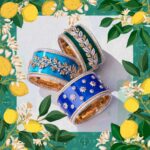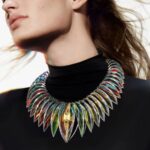
The Italian luxury jewelry brand Buccellati, known as the “Prince of Goldsmiths,” embarked on a brand “showcase” journey in Venice.
A historical retrospective exhibition titled “Prince of Goldsmiths” displayed important jewelry and silverware pieces from the brand’s 105-year history in one go. In a word: smooth!
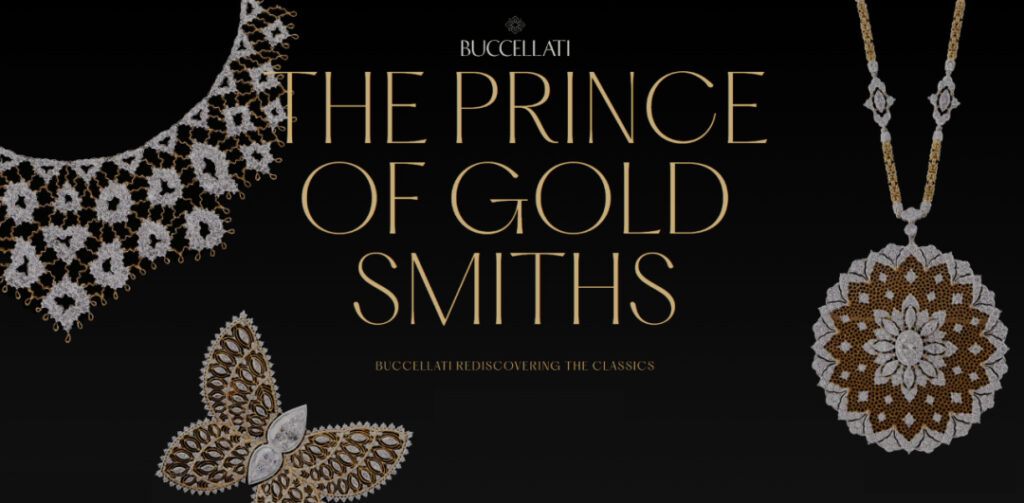
Through an immersive experience, the entire show took us on Buccellati’s creative journey, touching on themes and inspirations from Italian artistic heritage. The brand delved deep into how timeless artistic masterpieces are born, how extraordinary craftsmanship techniques are passed down through generations, and how classic beauty patterns are reinterpreted in our present era.
Let’s now appreciate the four themes of this show one by one:
THE BUCCELLATI GENERATIONS
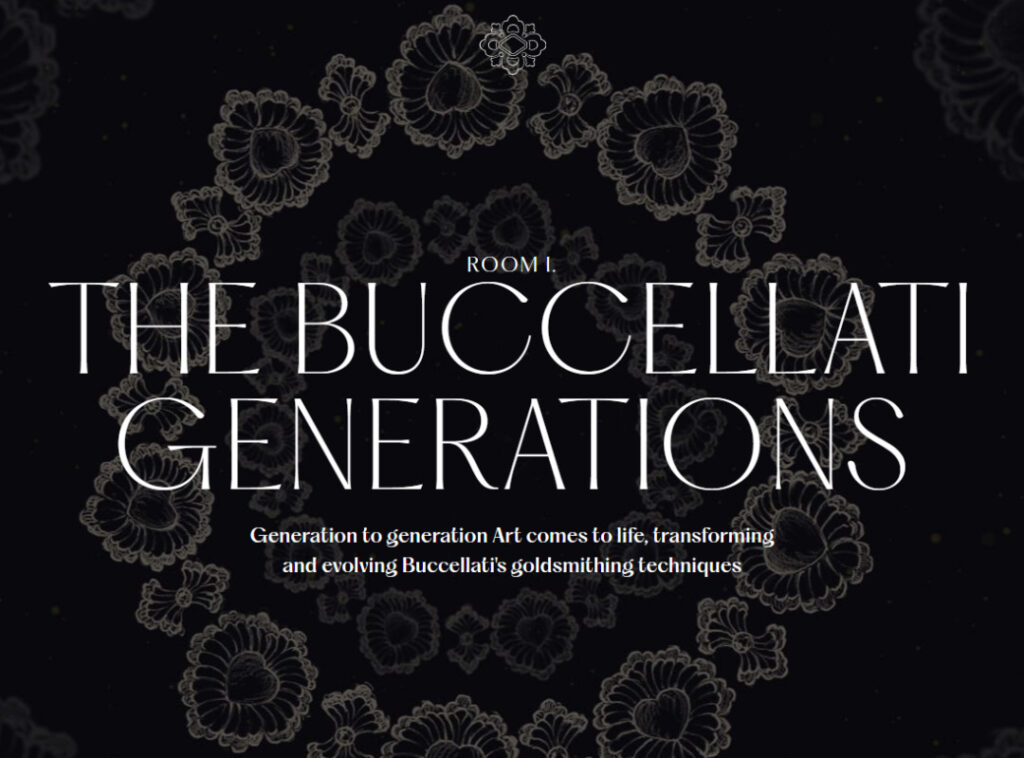
The core of this theme is “passing down through generations.” Gianmaria Buccellati, son of the brand’s founder, said: “From my father, I inherited craftsmanship, technical secrets, and aesthetic standards, all of which I passed on to my children.”
This theme, through elegant and delicate butterfly wings symbolizing metamorphosis, traces the evolution of the brand’s style from 1919 to the present, where generations of a family have rewritten the classics of beauty.
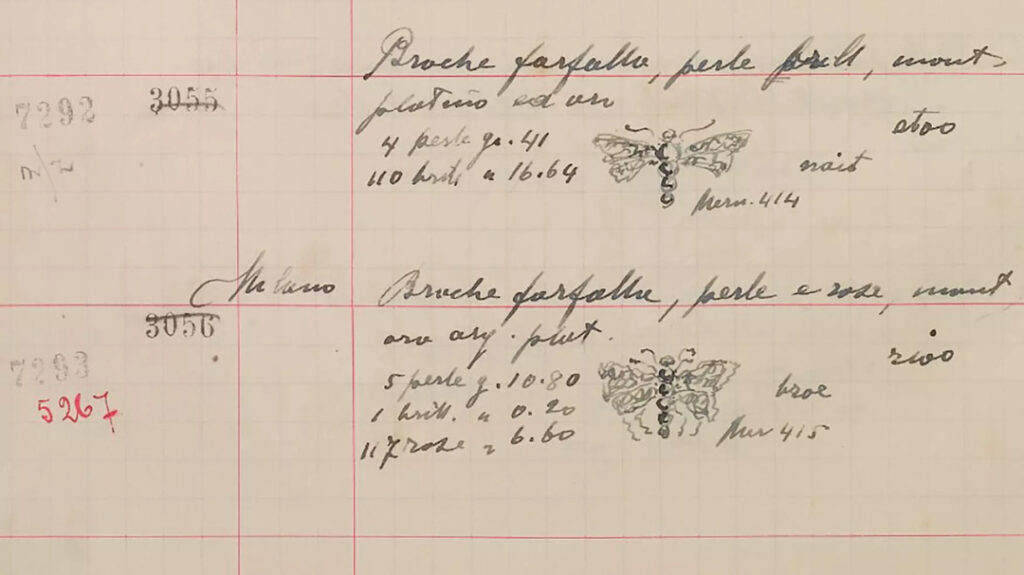
Brand founder Mario Buccellati drew inspiration from Burano lace embroidery in Venice, altering their patterns using complex piercing techniques. Geometric or leaf-shaped spaces with cuts and gemstones evoke lace embroidery.
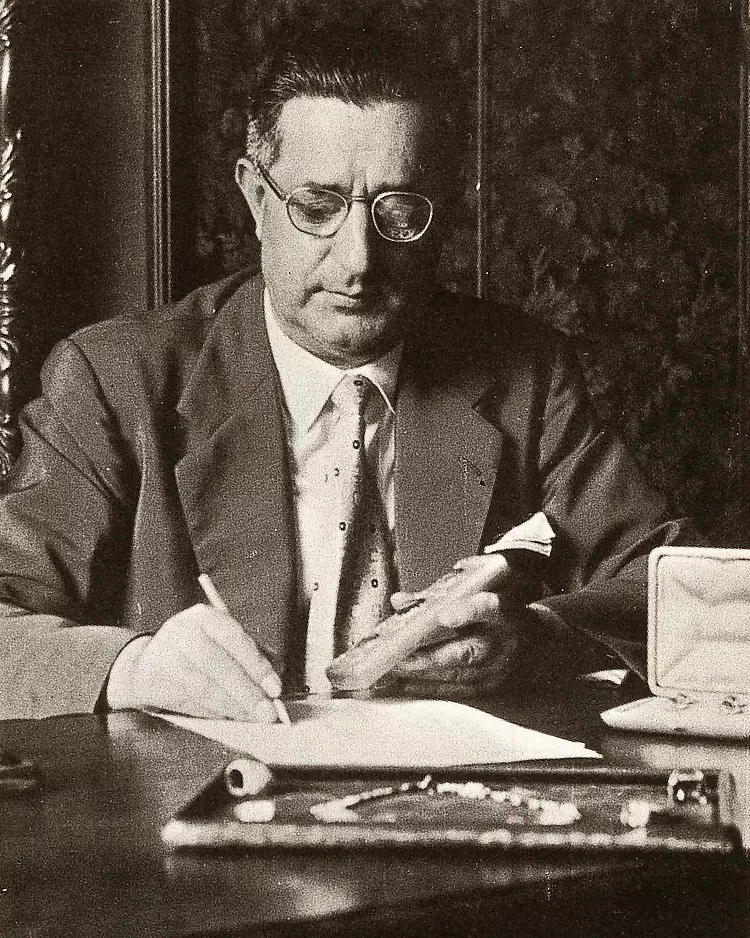
Mario was born in Ancona in 1891 but moved to Milan shortly after his father’s death. There, he apprenticed at a long-established goldsmith shop at 5 Via Santa Margherita in the city center, near La Scala. In 1919, he took over the business and founded the House of Buccellati.
During those years, Mario learned the best goldsmith techniques and materials from thousands of years ago, as well as how to manage craftsmen, but more importantly, he gained insight into customer tastes.

The handmade butterfly from the 1950s perfectly embodies Mario’s experience as an “exceptional man,” as Italian poet Gabriele d’Annunzio liked to call him.
This creature, with its slender body adorned with delicate white gold wings, has a body made of two baroque pearls, their transparency enhanced by rose-cut diamonds like dewdrops. The butterfly’s ruby-like eyes implore visitors to come closer and observe the precise and sculptural nature of its legs and antennae.
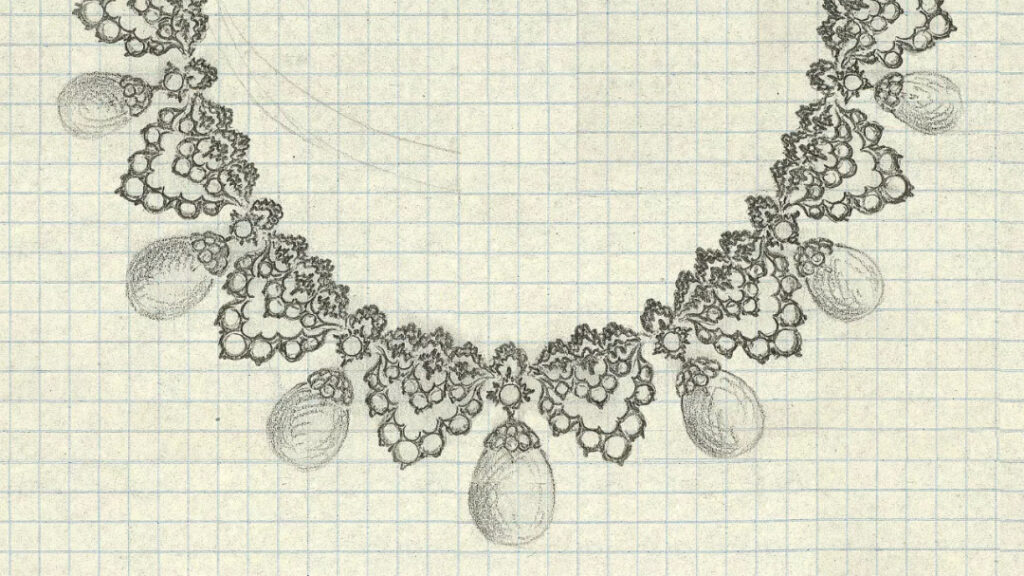
Gianmaria Buccellati, the fourth of Mario Buccellati’s five children, was the first to follow in his father’s footsteps, showing artistic talent and a natural gift for drawing from an early age.
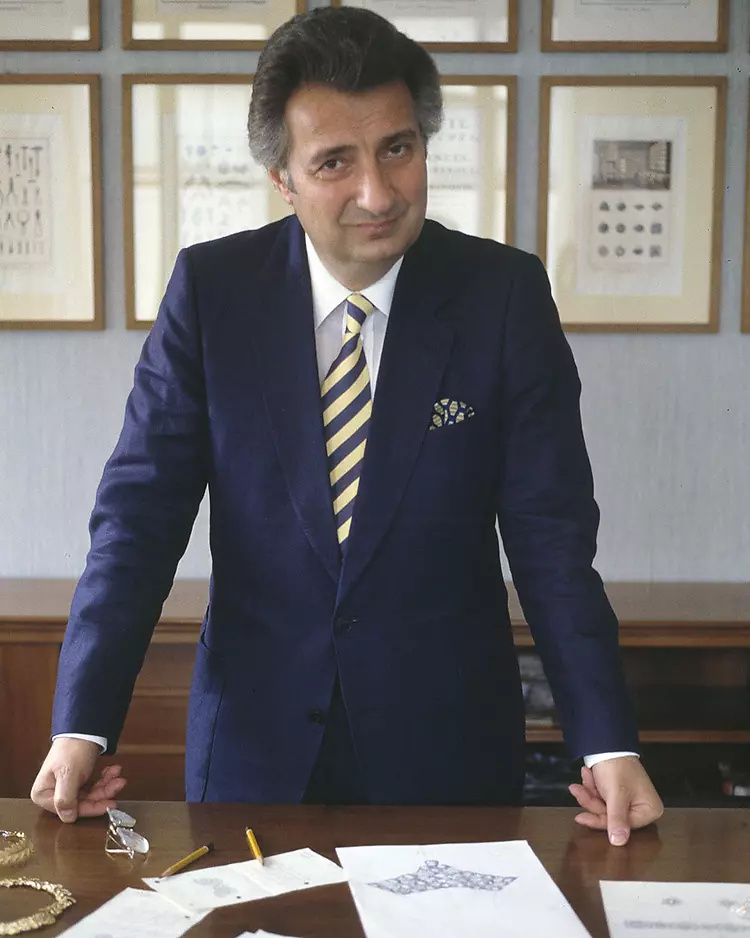
Born in Milan in 1929, Gianmaria began working in the shop and workshop at 14, learning the art of goldsmithing from the craftsmen. He was a visionary who knew how to combine creativity with entrepreneurship, personally overseeing all technical, artistic, manufacturing, and commercial aspects.
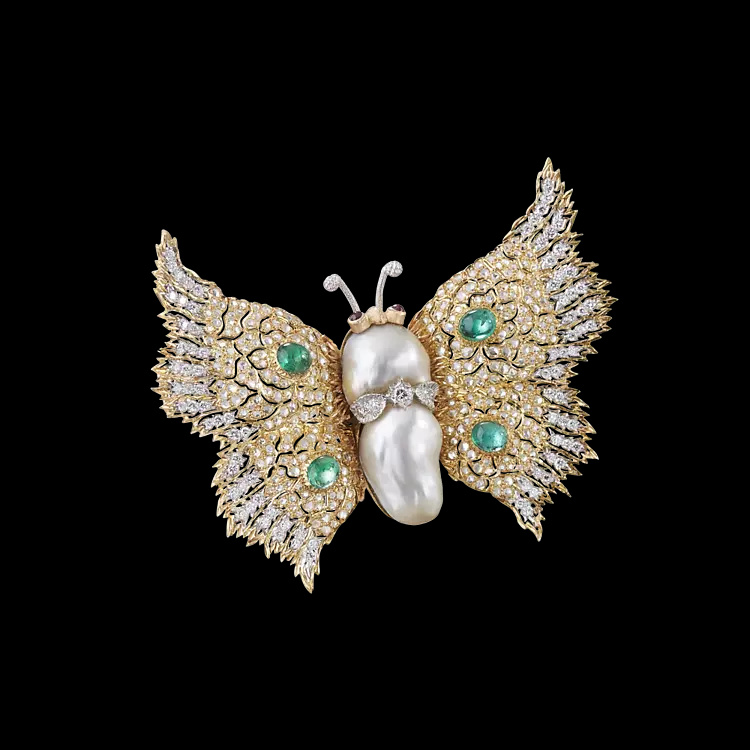
The butterfly exhibited, designed in 1993, clearly shows how Gianmaria’s style evolved from his father’s in different directions. Indeed, Gianmaria perfectly captured the love for color of the 1970s and the generous opulence of the 1980s.
The wings of this piece truly showcase his outstanding artistry, reflected in their alternating gold tones and intricate “modellato” engraving, as well as the carefully set diamonds and the colors of emeralds, rubies, and pearls.
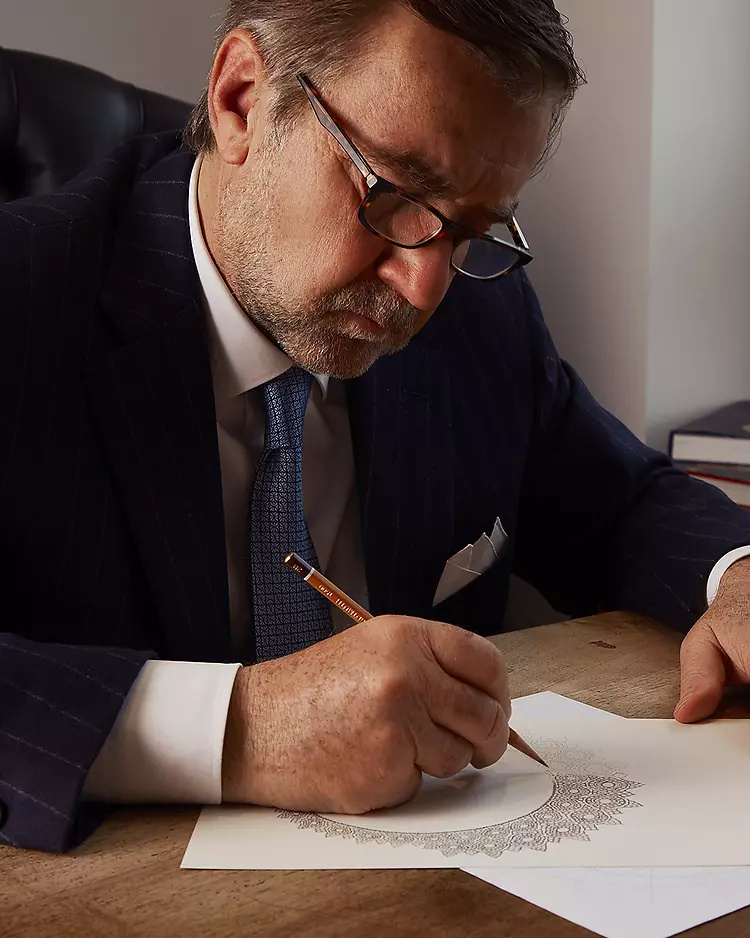
Andrea Buccellati, another son of founder Mario, joined Buccellati’s Milan studio with his father at 16. Today, he is the brand’s Creative Director and Honorary President.
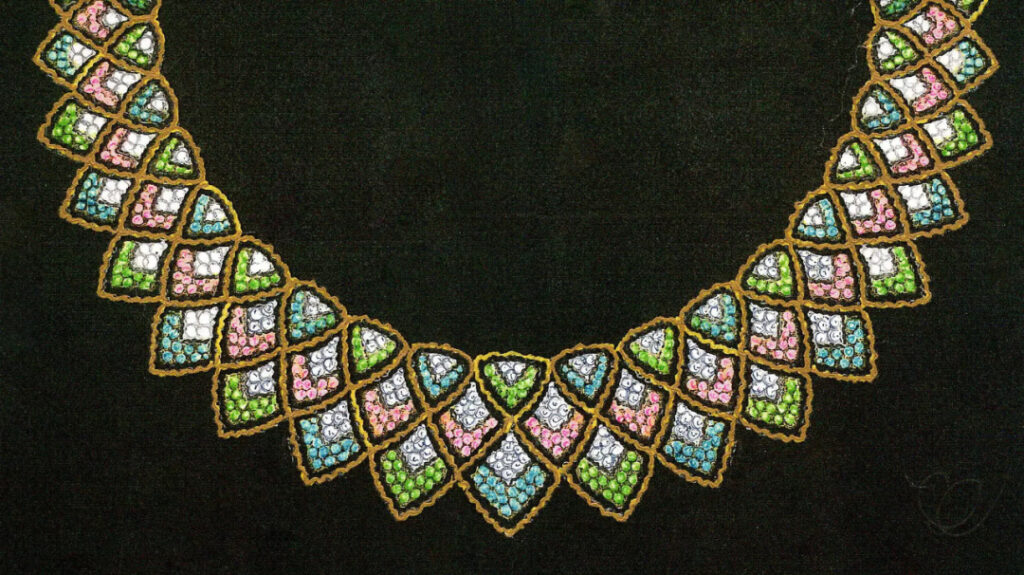
Andrea showed a talent for design from the beginning, a quality passed down through generations in the Buccellati family. Inheriting a fascination with art history, especially Renaissance art, Andrea was deeply inspired to construct beauty in balanced proportions. He is credited with adding contemporary aesthetics to the brand’s style.
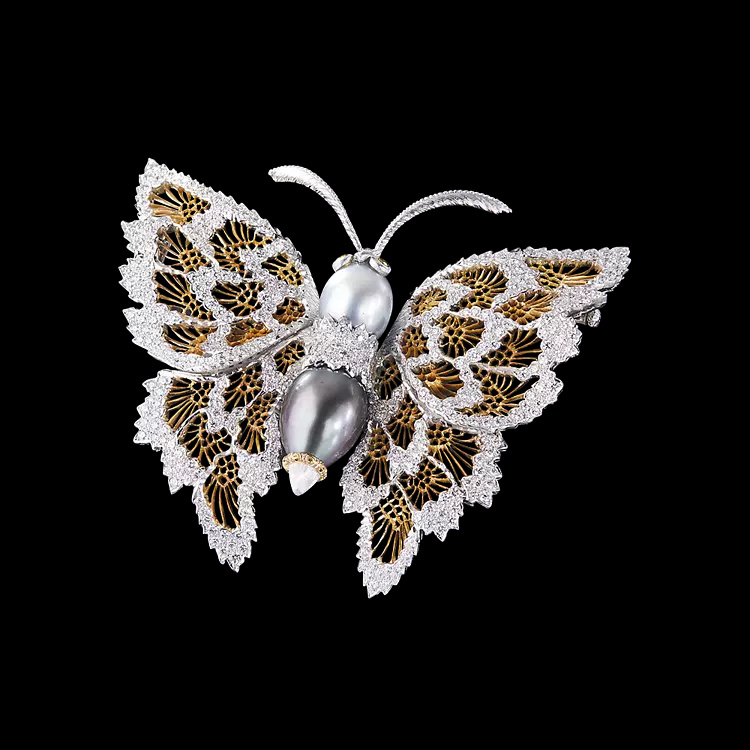
The butterfly designed by Andrea in 1995 perfectly reflects his departure from his father’s Baroque style and his respect for tradition. The delicate, light tulle-covered wings are adorned only with diamonds, leaving no room for color. At the same time, the butterfly’s body retains the Baroque-style pearls, their imperfect shape contrasting with the transparent wings.

Andrea is now creatively helmed by his daughter Lucrezia, who serves as the brand’s U.S. brand ambassador, representing the fourth generation of Buccellati designers.
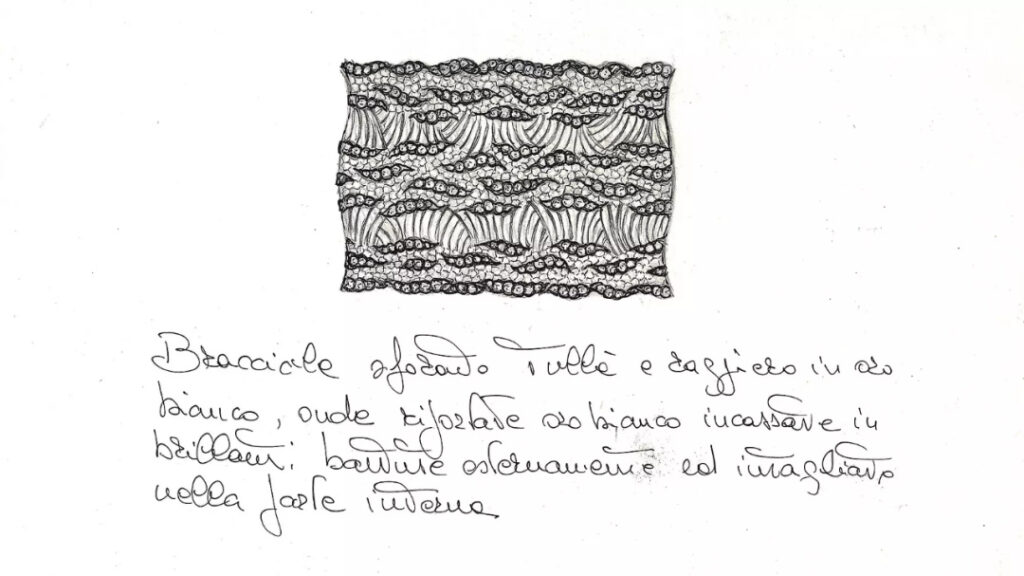
Lucrezia’s involvement in the brand’s artistic activities has become her true personal mission, and since 2013, she has been reinterpreting Buccellati’s style alongside her father. With a profound grasp of the aesthetics of millennial women, Lucrezia provides extensive inspiring insights in both styling and wearability.
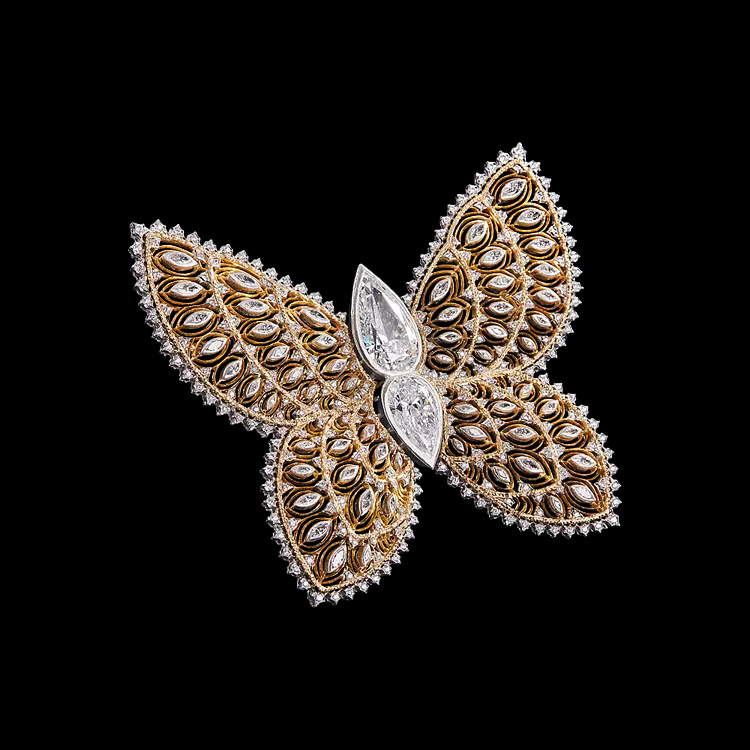
The butterfly designed in 2023 is the result of outstanding collaborative design between father and daughter, giving fans a glimpse into Buccellati’s vision for the future. This creation marks the evolution of tradition, notable in reworking honeycomb into sunburst patterns and “modellato” edges.
However, it also focuses on modernity through the stepped-cut diamonds on the wings and the sequence of pear-cut diamonds on the body, resulting in a perfect harmonious balance between rare preciousness and beauty.
MANMADE WONDERS
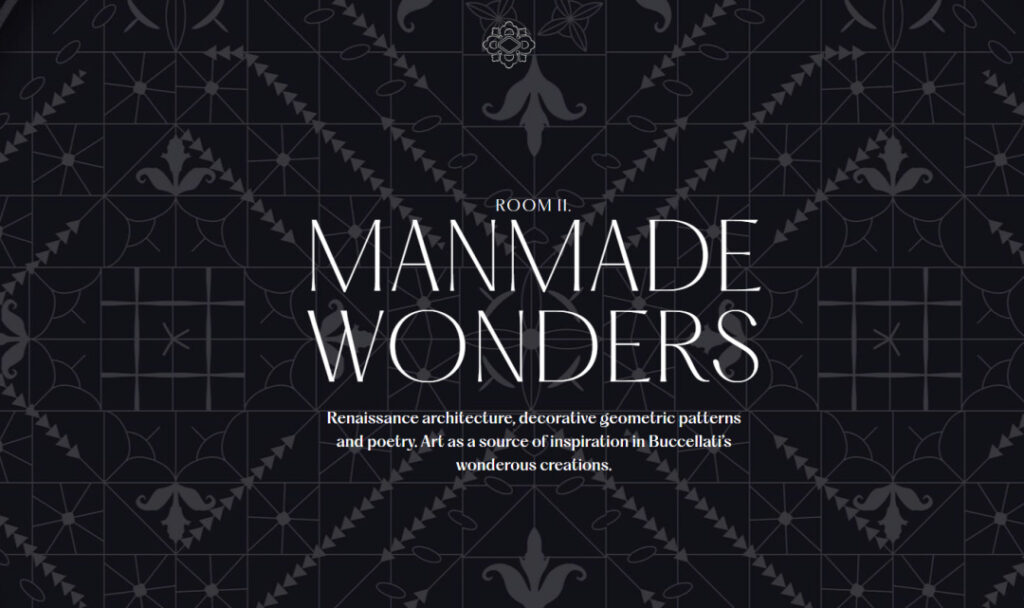
Renaissance architecture, decorative geometric patterns, and poetry serve as sources of inspiration for Buccellati’s marvelous creations. “Works are born from imagination and artistic contemplation; however, every source of creation must be sought in the temple of memory, recollection, and dreams,” says Gianmaria Buccellati.
Cigarette cases, wallets, boxes, and small accessories. Mario and Gianmaria, father and son, experimented with creating these small masterpieces, drawing inspiration from geometric decorative elements and intricate Renaissance architecture, not to mention the preciousness of fabrics.

The encounter with renowned poet, writer, and playwright Gabriele d’Annunzio played a decisive role in shaping the brand founder’s training, taste, artistic education, and aesthetic sensibility.
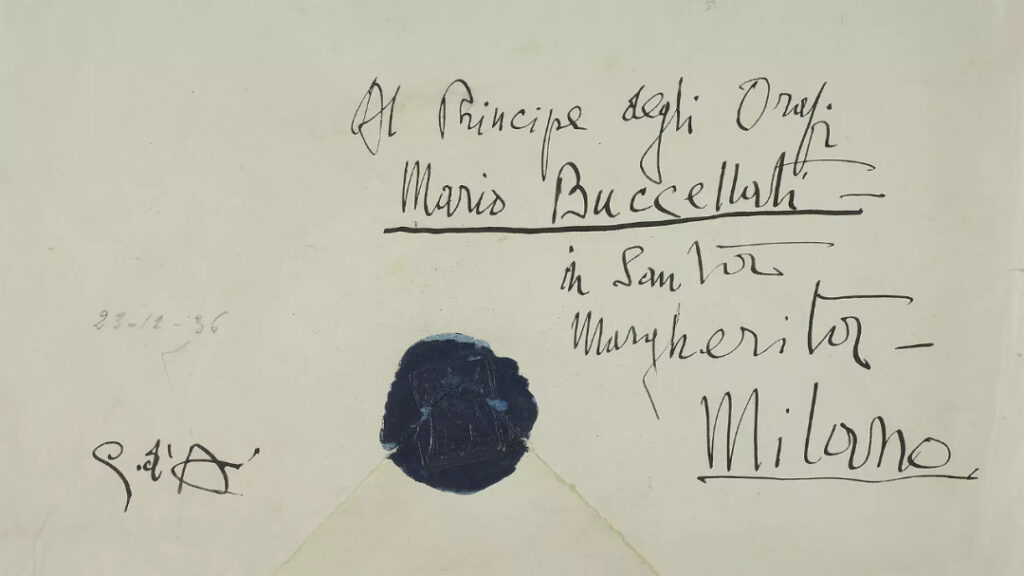
Their meeting took place on August 2, 1922. As d’Annunzio strolled along Via Santa Margherita, he stopped in front of Buccellati’s shop, captivated by the jeweler’s magnificent designs. From that day on, d’Annunzio would commission Mario to create hundreds of precious objects. He also maintained frequent correspondence with the latter, as evidenced by 83 letters written between 1922 and 1936, now part of the brand’s archives.
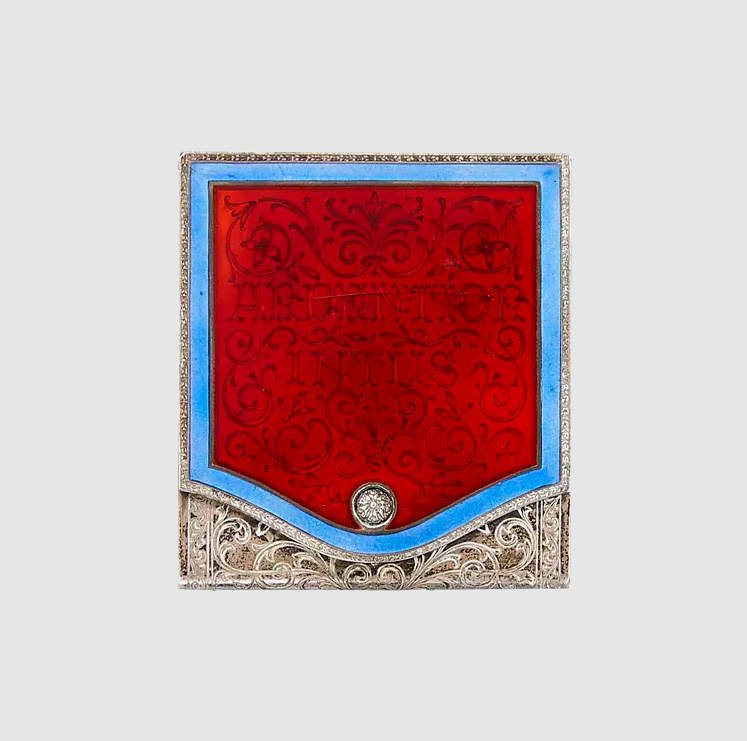
Among countless items, let’s revisit this exquisite matchbox from 1934. The intricately engraved silver surface intertwines with the motto “Ardentior Intus” or “Burning Heart,” adding a touch of the poet’s characteristic poetic irony.
The blue and red enamel pattern on the front of the book evokes the colors of d’Annunzio’s coat of arms – in 1924, the writer was awarded the title of Prince of Montenevoso by King Vittorio Emanuele III.
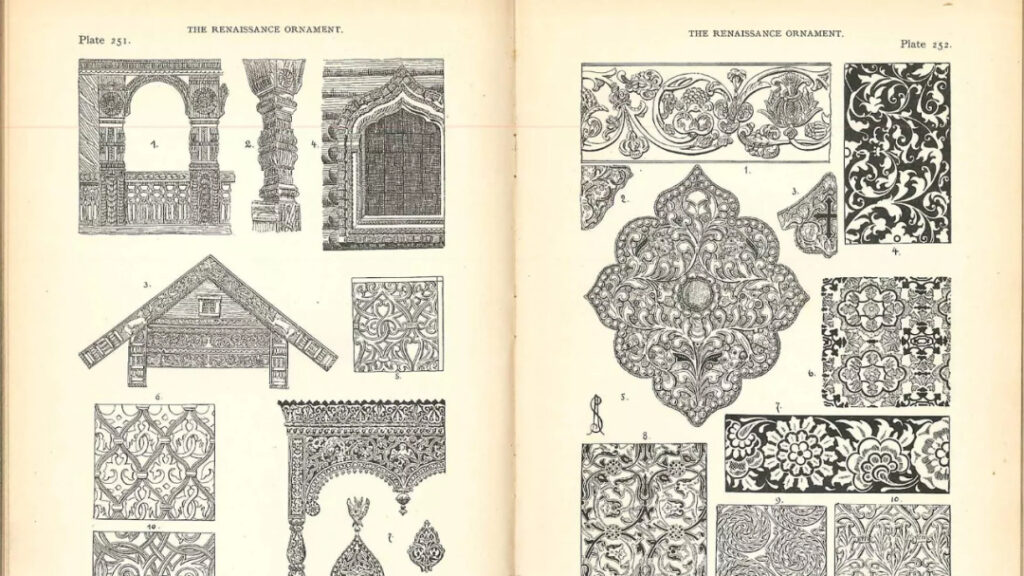
Buccellati captivates us with geometry, combining art and precision in the interplay of shapes, inspired by celestial architecture and Renaissance elegance.
The Buccellati style is characterized by geometric shapes found in many of the brand’s collections. These elements, patterns, and almost sculptural engravings evoke decorative friezes, mosaic floors’ rhythms, and all those shapes reminiscent of past eras’ splendor.

The Buccellati archives preserve a unique set of small paper pieces called “Tre.” Almost like photocopies, they feature various geometric and floral patterns meticulously engraved by craftsmen on boxes and small accessories. Among the diverse themes, it’s worth recalling the sun, the Visconti-Sforza family coat of arms (pictured above), the emblem of the Dukes of Milan, and the labyrinthine ceiling of the Ducal Palace of Mantua.
This exquisite cigarette case, dating back to the 1930s, features a silver surface engraved with perfect geometric decorative patterns reminiscent of the most inspiring Renaissance designs.
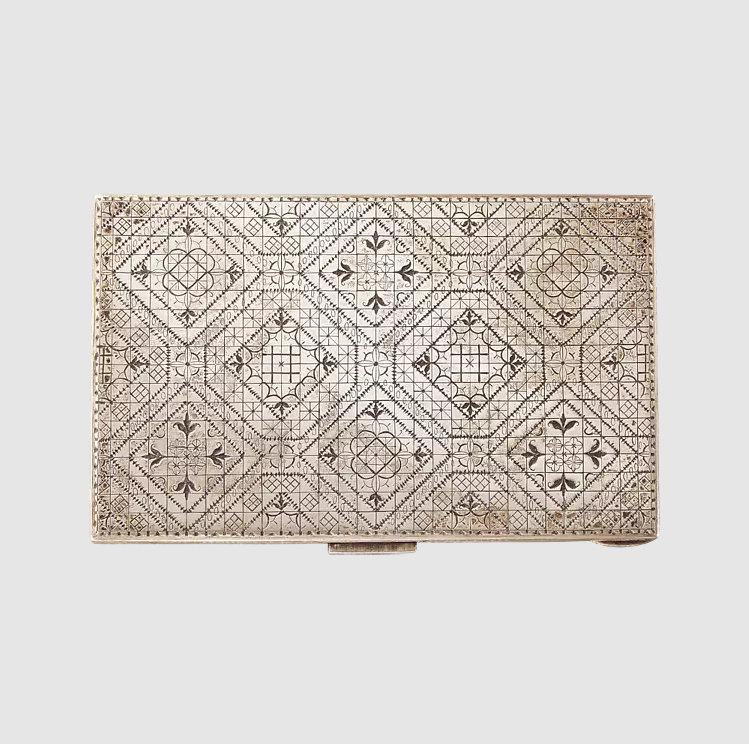
The endless pursuit of beauty prompted Buccellati to create numerous precious objects for both special and mundane occasions. In the 1930s, soft fabric handbags like the one pictured below were highly popular at grand evening events.
Mario Buccellati understood their importance to the extent that he transformed them into something as precious and coveted as jewels, turning their fasteners from functional elements into decorative pieces.
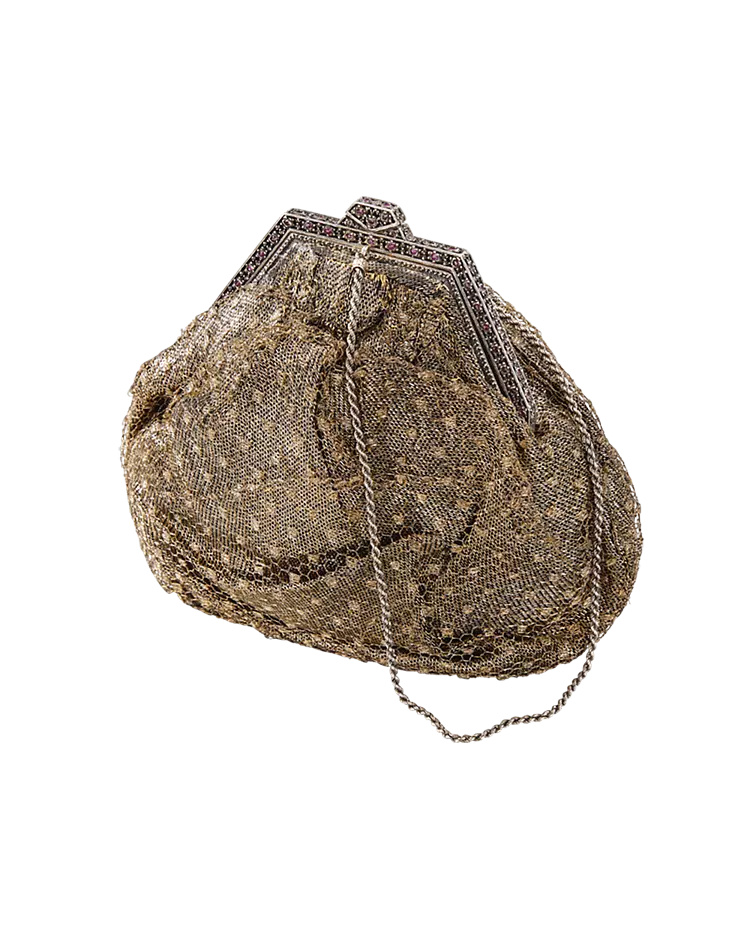
Mario wasn’t immediately inspired by the shift towards slimmer silhouettes in the 1950s. However, he adapted to the new trends coming from America and brought his unique signature: engraving. This technique visually softened the metal-like silk fabric with damask patterns.
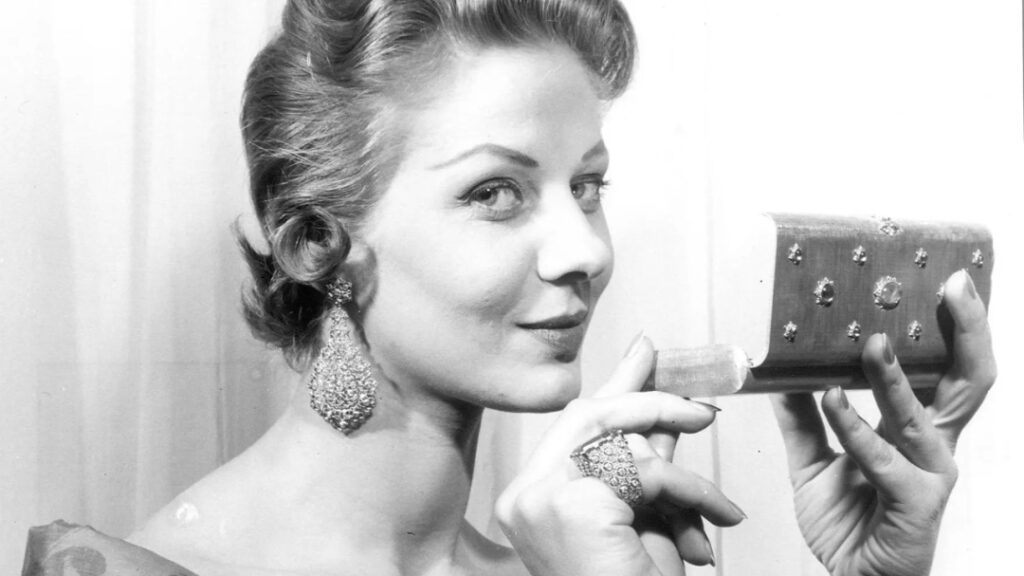
This rectangular vanity case from 1964 is made of “telato” engraved silver and adorned with a wreath of roses in “modellato” yellow gold alternating with blue and pink sapphires. An artistically refined masterpiece combining the practicality of an accessory with the luxury of jewelry.

Buccellati’s deep love for art history creates precious objects and jewelry that transcend any era, drawing from its constant inspiration.

From Rome to Byzantium, from French Gothic to Florentine Renaissance, from Venetian Baroque to Rococo, from Romanticism to Neoclassicism. Art serves as an aesthetic, qualitative model deeply embedded in Buccellati’s jewelry and precious objects. It’s not just decorative inspiration. Rather, inspiration works in tandem with technique to create a perfect symbiosis of form and function, much like in architecture.
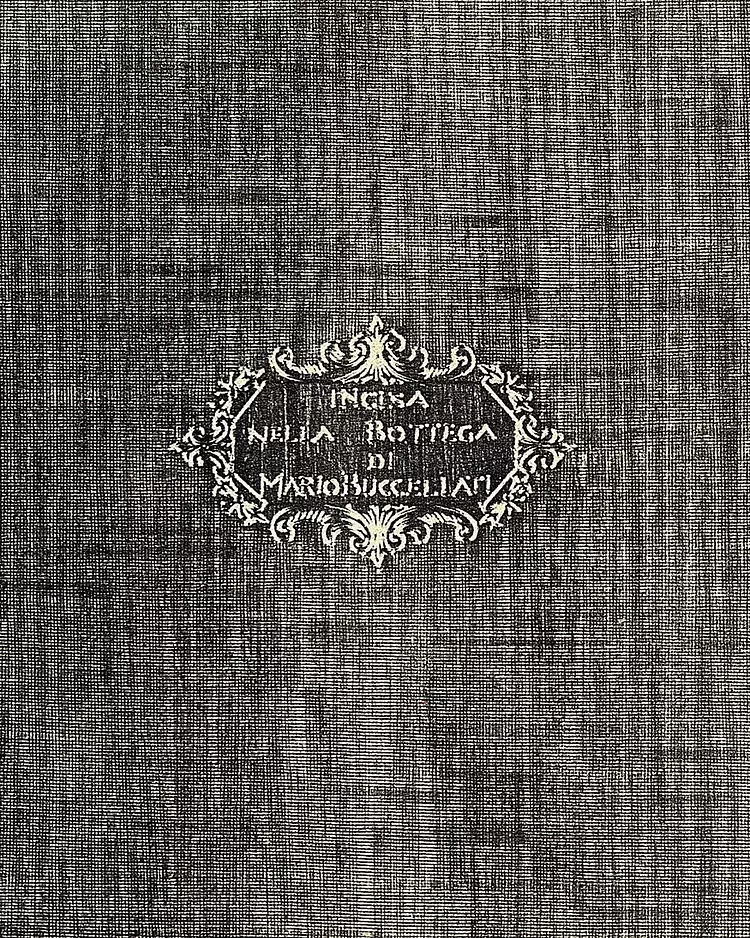
This precious gold and silver lunchbox, designed by Gianmaria Buccellati in 2001, exemplifies such a fusion. Here, we see the captivating engraving of the Paris Nôtre-Dame panorama, which also serves the box’s function as an artistic container.
The manufacturing process makes the details even more precise. Craftsmen use reference prints to track grids, following them during the engraving phase to ensure accuracy in proportions and details. The result is a piece that attracts us with its beauty and elegance.
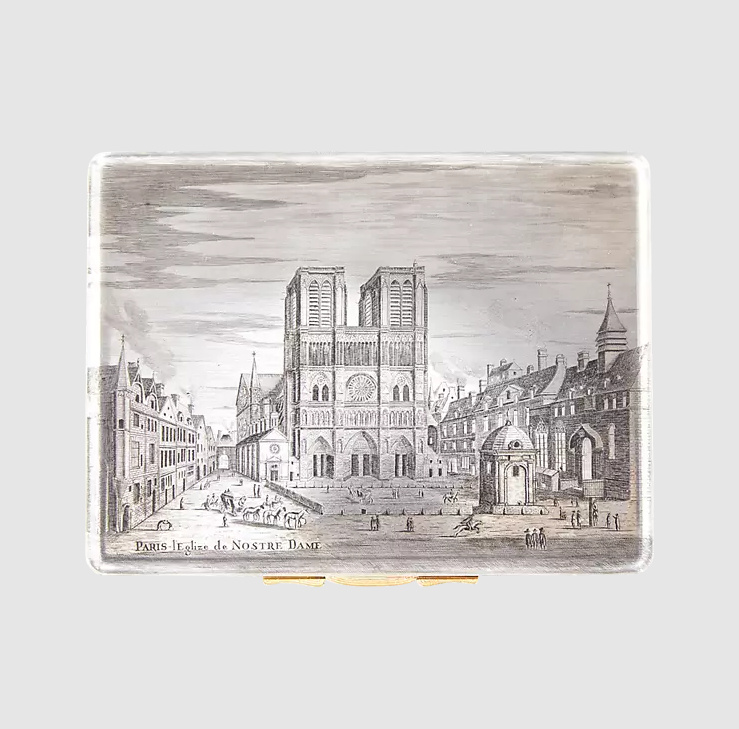
NATURAL WONDERS
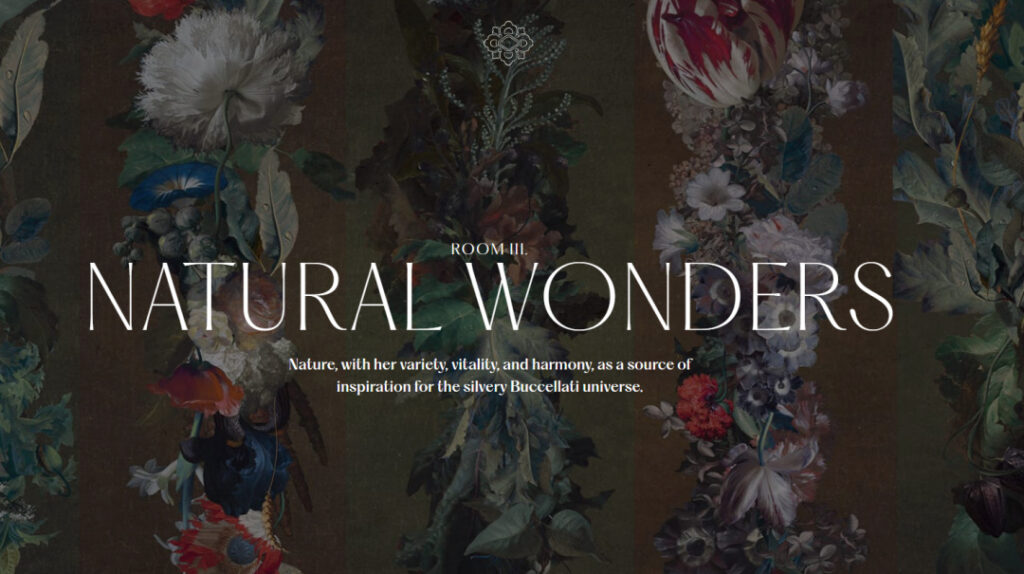
Nature, with its diversity, vitality, and harmony, serves as a source of inspiration for Buccellati’s silver universe. The founder, Mario Buccellati, once said: “Making silverware is like kneading bread; the more you knead it, the more beautiful it becomes.” Buccellati’s art reveals a silver universe where curved shells, embossed leaves, blooming buds, succulent fruits, and bristly animals adorn cutlery, tableware, candlesticks, centerpieces, and cups.
As Aristotle and Buccellati affirm, “In all of nature’s realities, there is something marvelous.” Mario Buccellati, originally a silversmith, was never inspired by the typical designs of his time. Instead, he developed his own original and innovative product lines.
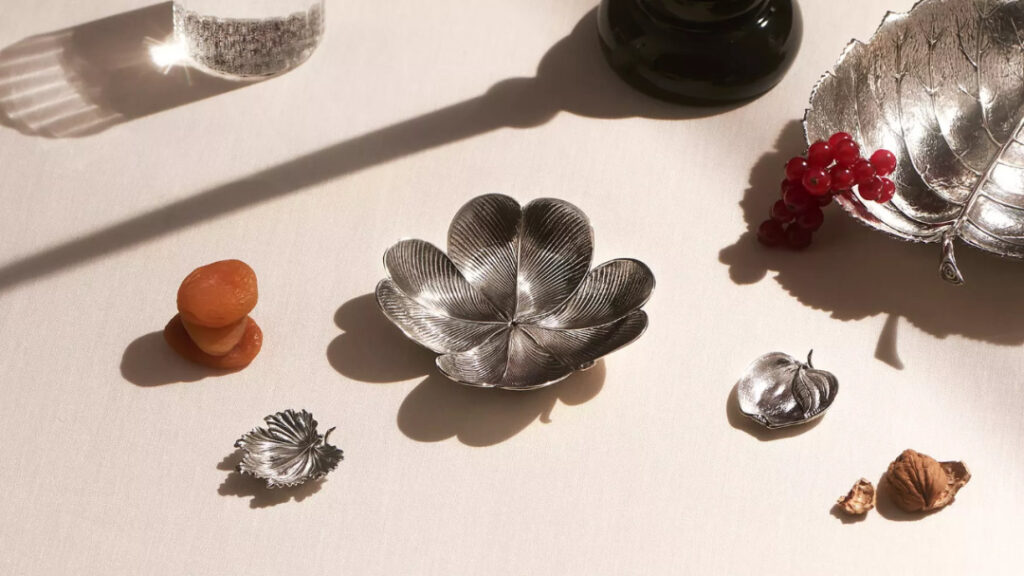
Even today, skilled artisans continue to forge and shape objects of extraordinary value and refinement. These items draw inspiration primarily from a variety of natural forms, leaves, and flowers, as diverse as those found in a meticulously curated herbarium.
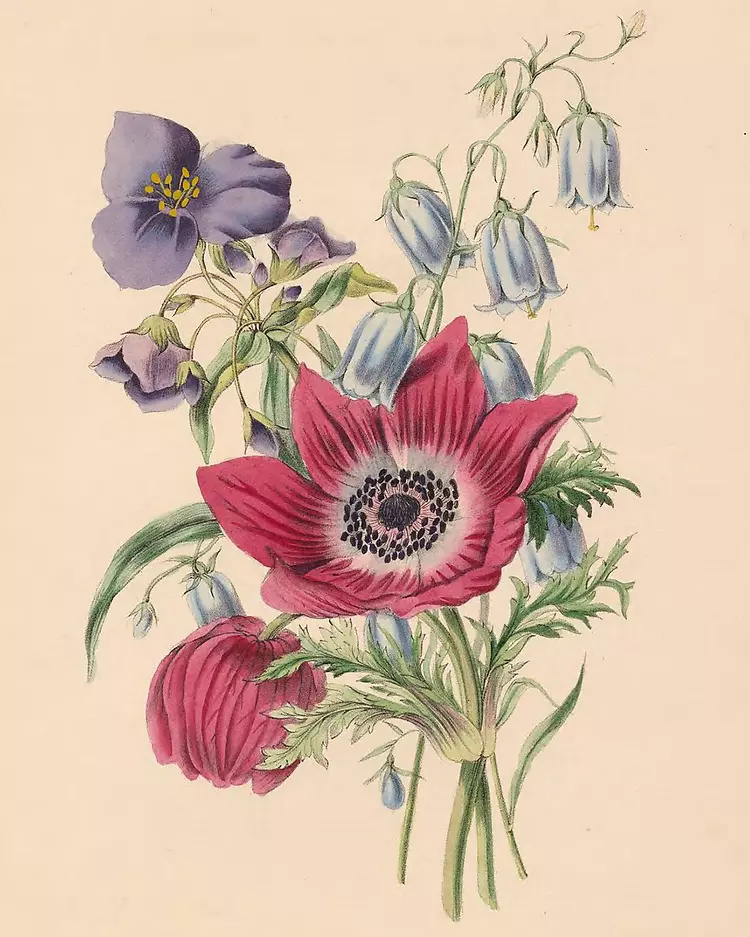
The intuition of Gino Buccellati, Gianmaria’s eldest son, brought many of the brand’s iconic pieces to life. Among these are the famous leaves and flowers from the Natura collection: elegant and refined bowls and trays, including this daffodil with its subtle veins and crinkled petals, which quickly came to represent Buccellati’s signature style.

Nature isn’t just about tender shoots, leaf veins, and wrinkled bark—it’s also the provider of precious gems and materials, reminding us of the gifts bestowed upon us by the earth.
Moreover, amidst this lush greenery, we discover elegant, furry animals. Gianmaria Buccellati successfully replicated their fur and feathers using the “pelage” technique to create a highly realistic effect. Employed since the 1960s, this technique mimics the appearance of animal fur by invisibly welding countless silver threads of varying lengths and thicknesses together.
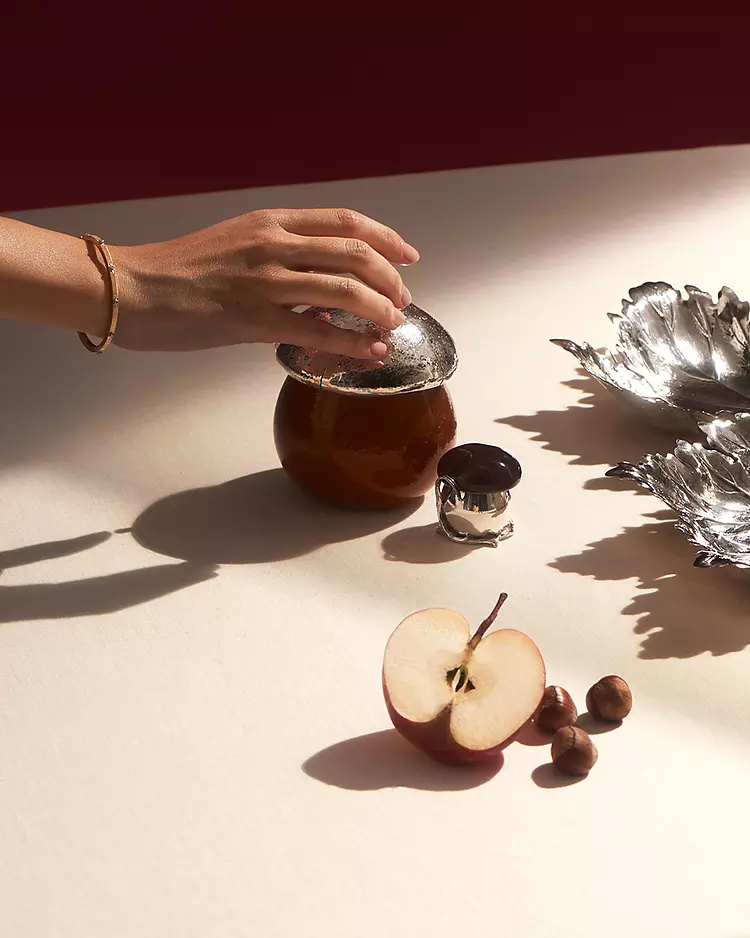
Artisans first grind silver sheets with special scissors, cutting out small strips of feathers or fur. Next, they create a clay model of the animal, which is then used to make a metal mold. The mold’s interior is lined with the ground silver strips, and the two are welded together to form the animal’s body.
In this way, we see squirrels, fawns, ducklings, owls, and entire menageries come to life in silver, with Buccellati’s expert craftsmanship successfully rendering every detail with extraordinary realism.
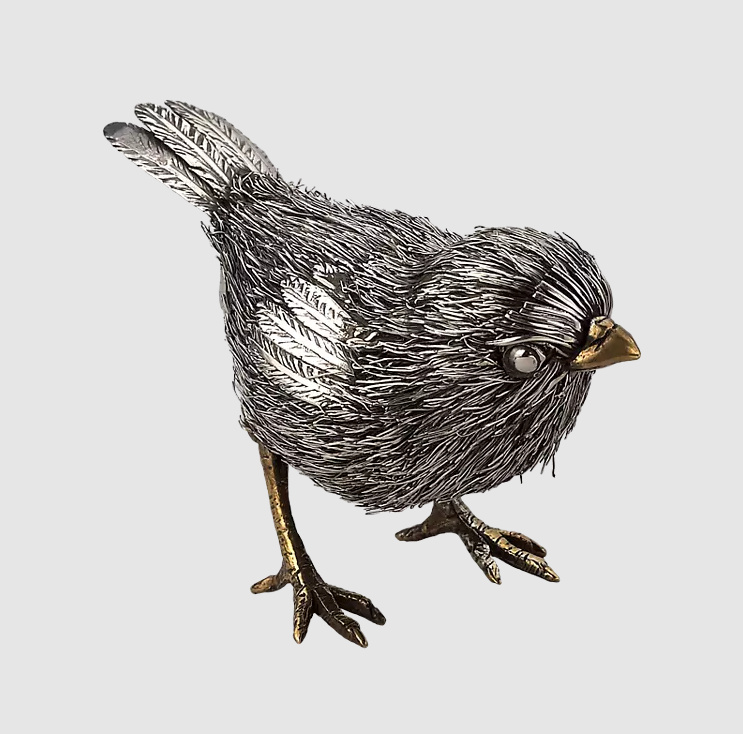
Nature infuses Buccellati’s creations through highly sculptural forms, evoking the magic of the marine world, resembling an army of “shrimps and crabs” at first glance, haha!
Gianmaria and Andrea Buccellati further enriched the table with various precious items—silver-plated shells, centerpieces of crustaceans and mussels, box crabs with coral eyes, lobsters with rectangular antennae, and octopuses fixed on ruffled shells.

We also find real shells of different shapes and sizes covered in silver, including Murex Ramosus and Nautilus Pompilius. These marine jewels have always been a source of fascination, with their elegant and mysterious contours, while also symbolizing prosperity, rebirth, and fertility.
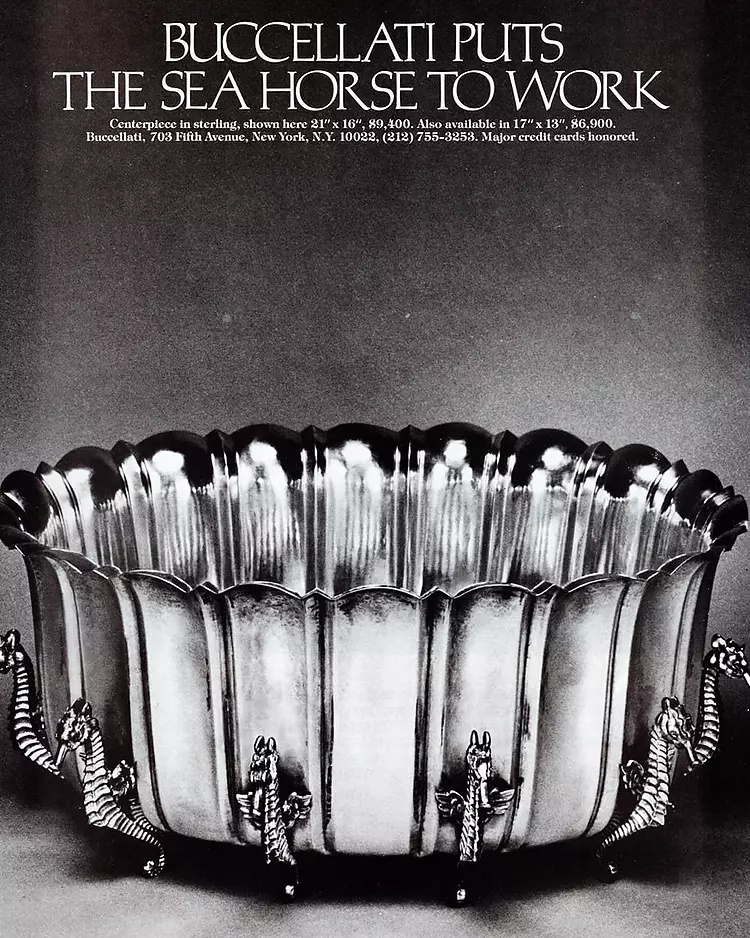
This famous advertising series from the 1970s, preserved in the brand’s archives, showcases unique silver pieces inspired by the depths of the ocean with captivating and playful slogans.
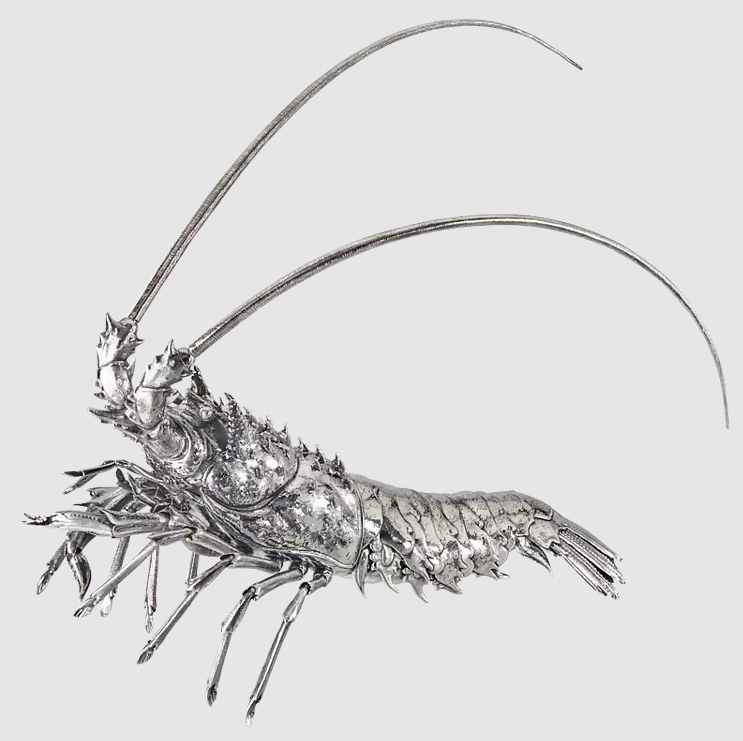
THE GALLERY OF THE ICONS
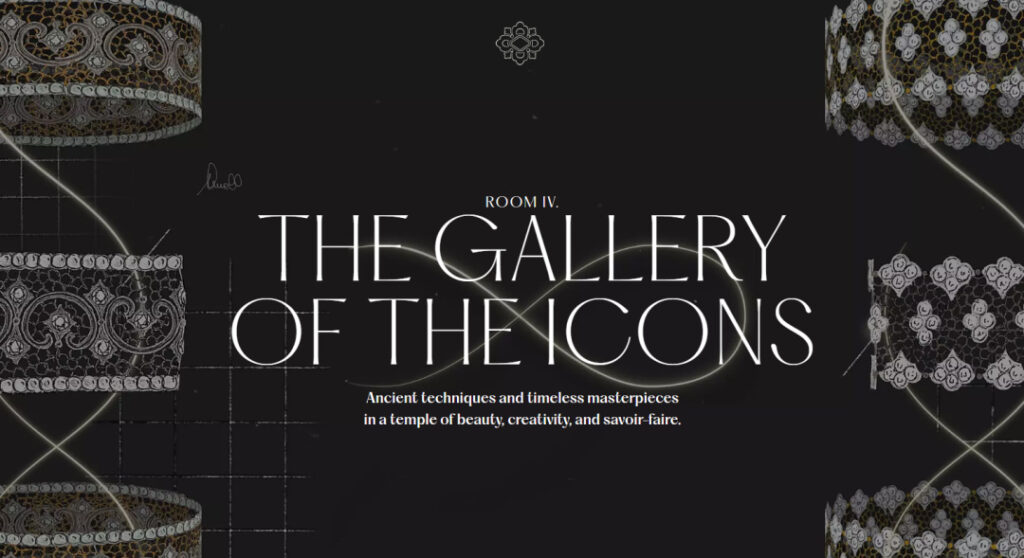
Andrea Buccellati once said, “Exquisite craftsmanship cannot be improvised; it must be nurtured with patience, allowing it to slip into our DNA to bestow creations with eternal beauty.” In this gallery, we showcase the Buccellati family’s interpretation of Buccellati icons, in an imaginary dialogue about beauty and creativity spanning a century.
Lace, this precious technique involves piercing thin sheets with a saw to form a geometric or leaf-shaped lattice on which gems and diamonds can be set.
It’s a complex process that requires a great deal of skill and extreme precision in execution. This is because the tiniest mistake could render all the work futile. In fact, a goldsmith will spend more than a month cutting gold, then working with diamonds or precious gems to achieve the ethereal lightness of the brand’s masterpieces.
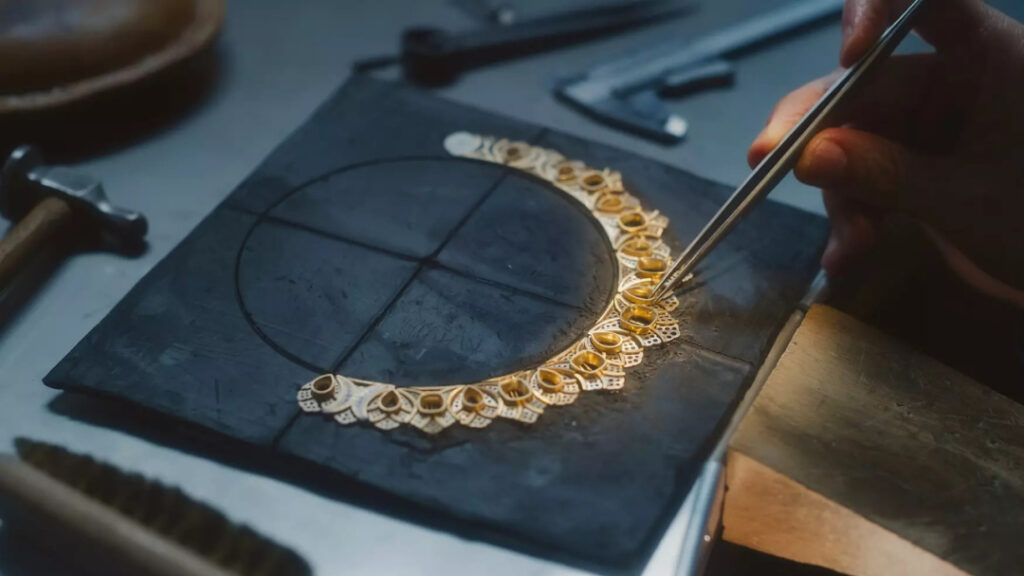
The “Pizzo” or lace technique made Mario Buccellati world-renowned. From the beginning, he was inspired by the delicate Venetian embroidery made with Burano needles, transforming their patterns with intricate piercing techniques.
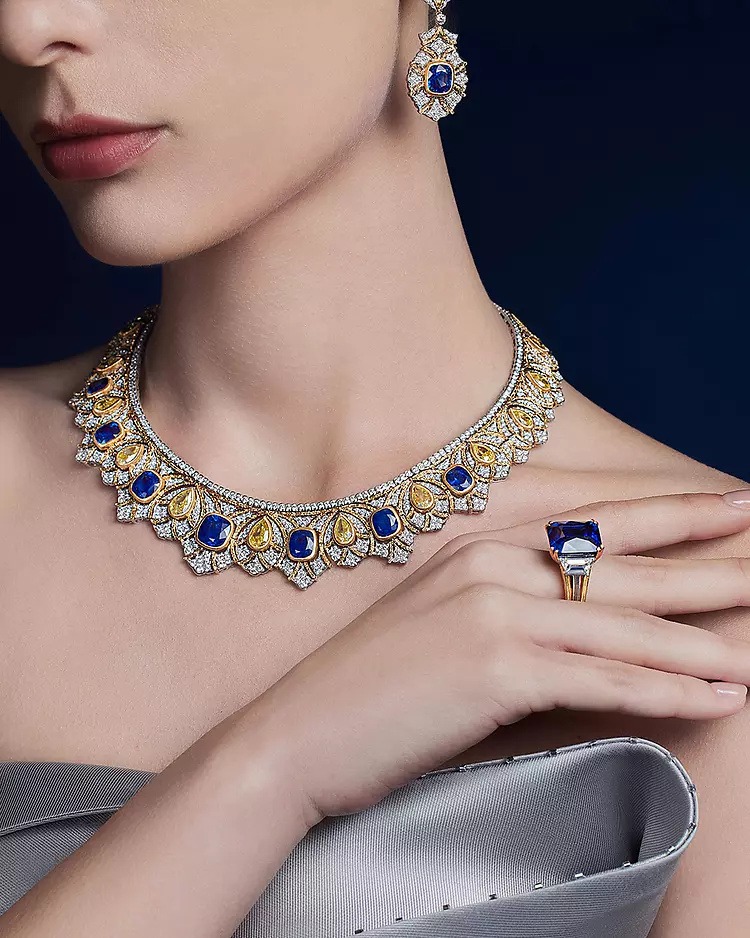
One of Mario’s early masterpieces is this magnificent wrapped bracelet made in the 1920s, pictured below. This piece, made of gold-lined silver, features four large lace rotating medallions adorned with 1,264 rose-cut diamonds (15 carats) and 192 8/8-cut diamonds (5.20 carats).
At the center of the bracelet, alternating gold with “modellato” engraved borders further enhances the brilliance of 4 old-cut diamonds (4 carats). A soft, elegant, “Milanese” masterpiece.
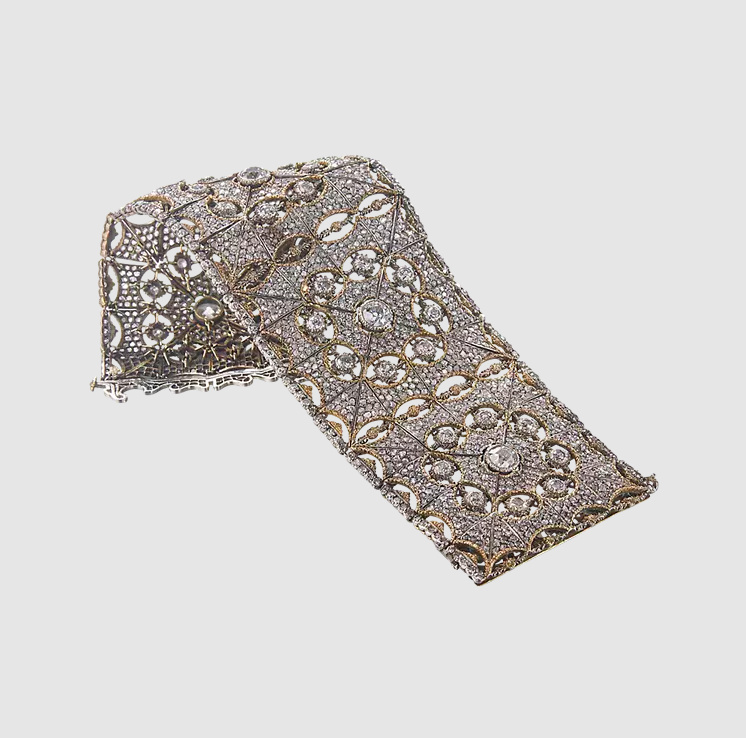
“Honeycomb,” also known as “Tulle,” is what we often refer to as the “beehive” technique. This process involves piercing tulle with a steel saw until a network of tiny polygonal holes is formed.
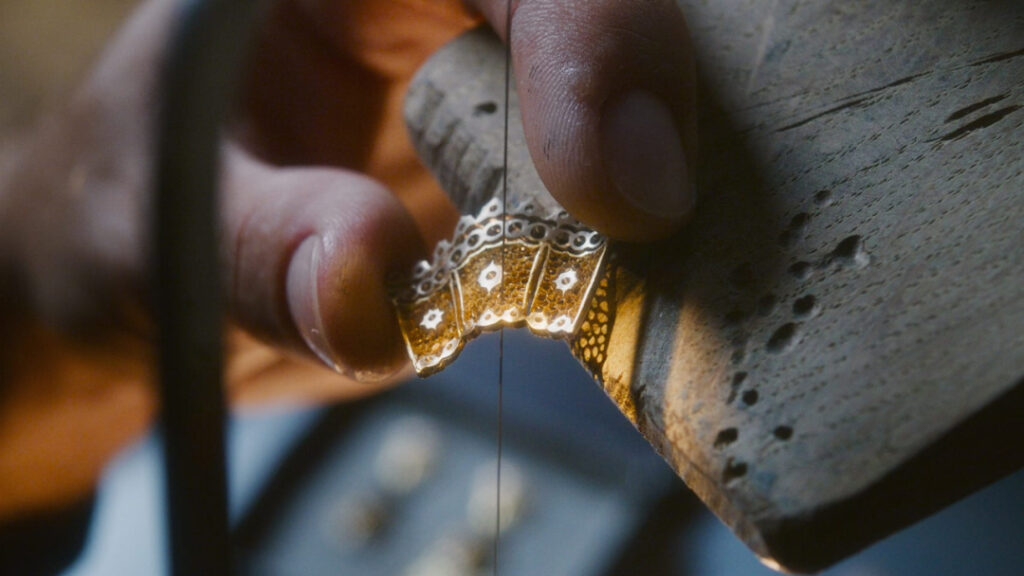
The creation process begins with the artisan tracing the design onto the surface of a precious metal sheet. Next, the marked gaps are carefully drilled by hand, with each hole finished in the required form, whether hexagonal or pentagonal, using a jeweler’s saw blade. To ensure the perfection and regularity of the tulle design, each unit must be refined at least five times.

Gianmaria Buccellati’s pendant earrings are an original interpretation of this technique, a tribute to the multi-lobed openings of the Venetian Doge’s Palace. Concentric teardrop edges embrace two white gold flower outlines that open in the center of a very fine golden grid.
The brilliance of 659 brilliant-cut diamonds (6.54 carats) further enhances the brightness of the relief, while the alternating colors of different types of gold, typical of the Buccellati style, give the creation greater prominence and contrast.

Inspired by Renaissance craftsmanship techniques, Mario Buccellati and his heirs transformed the art of engraving, making it the brand’s preferred technique. This technique evolved into five original and unique crafts that define the Buccellati style: “rigato,” “telato,” “segrinato,” “orato,” and “modellato.”
Although most goldsmith engravings are now mechanically produced, Buccellati has always insisted on handcrafting, with the engraver’s manual skills playing a decisive role in the quality of the work.
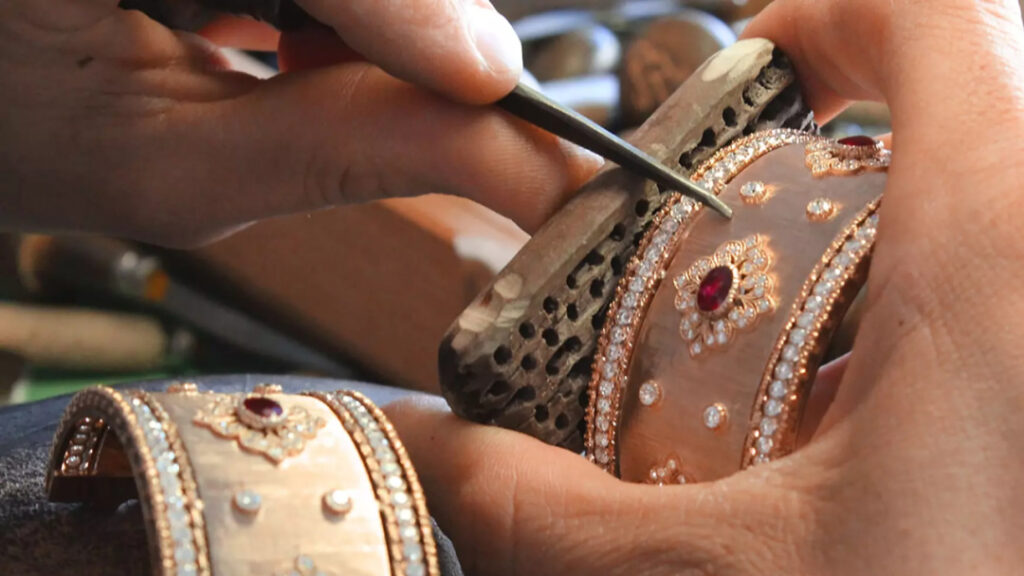
As Andrea Buccellati states, “Over the past 60 years, this engraving has almost completely disappeared due to its high cost, but for us, it remains important to preserve it because it is synonymous with high-quality handwork.”
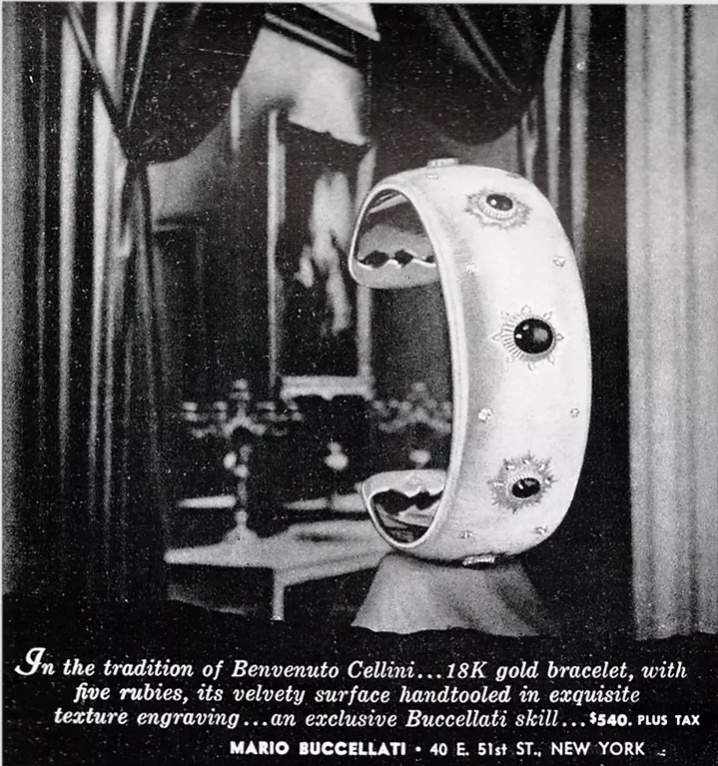
This special Renaissance-era technique is embodied in the iconic cuff bracelet, featuring the “rigato” variation, a cut made of many thin parallel lines that create brightness similar to the texture of textiles.
This bracelet, designed by Andrea Buccellati in 2014, boasts a smooth white gold surface that shimmers brilliantly, further enhanced by three openwork yellow gold rosettes set with 162 rose-cut diamonds (2.11 carats) and 95 brilliant-cut diamonds (2.11 carats). The “ornato” cut gives the three floral rosettes additional richness.

“Enchaining” is the combination of elements that are connected using small links at the back of the jewelry to achieve maximum flexibility.
This technique requires engineering skills combined with ergonomic studies. Indeed, it challenges the family’s creative members and the brand’s craftsmen to research links, shapes, and components small enough to wrap around the wearer like soft fabric.

This technique allowed Mario to create famous gold-rimmed silver bracelets, and now Gianmaria and Andrea increasingly use it to make elegantly soft and comfortable items to wear, such as impressive bib necklaces.
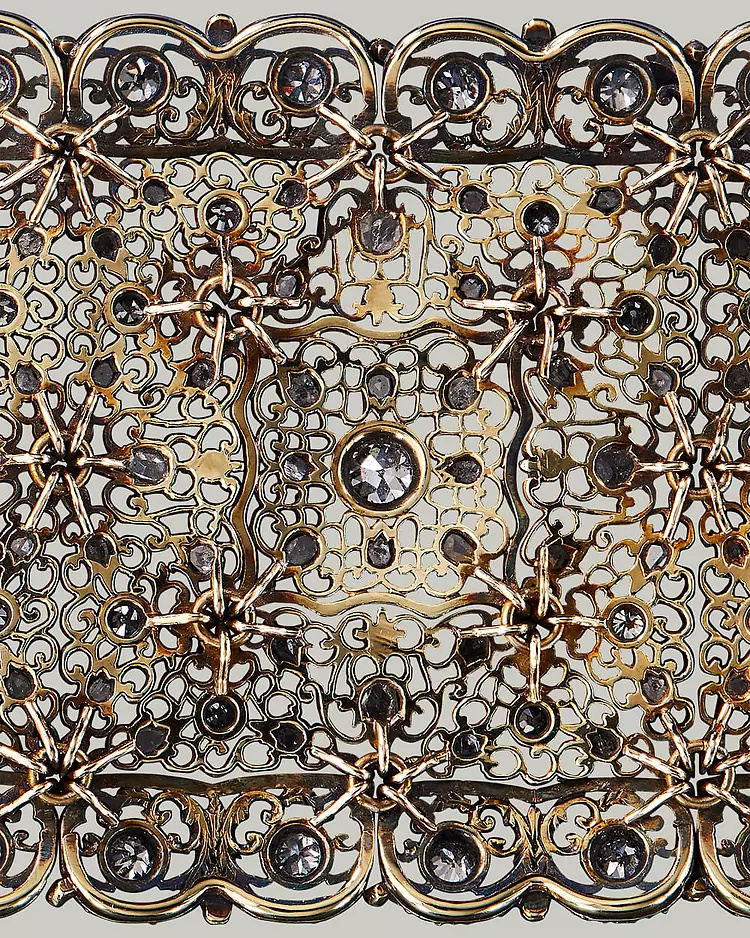
Gianmaria Buccellati’s 1992 set of a necklace, pendant earrings, and flexible bracelet represents a careful study of space and form, with an elusive lightness and transparency in the combination of technique and aesthetics.
Countless white gold outlines are connected by a row of small golden rounds and holes, as if they were a Venetian lace thread. Innumerable brilliant-cut diamonds further accentuate the luxury of this jewelry set: 946 (17.29 carats) for the necklace, 268 (6.5 carats) for the earrings, and 448 (6.63 carats) for the bracelet.

In the 1920s, haute couture was at the height of fashion due to its ability to adorn smooth, curvy silhouettes. They marked an era of great change for women and their social roles, signaling the beginning of women’s social and cultural liberation.
Always in tune with fashion trends, Gabriele d’Annunzio named these long necklaces “Ombelicali” because of their length, with pendants elegantly hanging down to the navel.
The poet commissioned Mario Buccellati to create several different versions for his muses, including Eleonora Duse, Ida Rubinstein, Elena Sangro, and Marchesa Casati Stampa, referring to them as “cheerful” necklaces due to the bright colors of the semi-precious stones and the subtle nuances of baroque pearls.

The precious Ombelicale necklace on display was designed by the founder in the 1930s. It consists of a long string of baroque pearls interconnected with finely crafted golden cups and a thin silver chain. On the other hand, this pendant features a silver teardrop structure threaded with leaf patterns and golden pearls, where 99 baroque pearls stand out for their irregular shapes.
Today, the Ombelicali necklaces are reinterpreted by Andrea Buccellati with a modern twist. This pale purple jade necklace features cups engraved with the “rigato” pattern. Meanwhile, this luxurious version with gray pearls reminds one of Renaissance portraits, as it adorns spheres with multi-petaled diamonds made of finely carved yellow gold.

Buccellati not only defined a jewelry style but also designed new types of goldsmiths’ work, such as the famous “Eternelle” rings.
The idea for these rings comes from the concept of eternal love, like an endless circle with no end. The founder coined the term in the 1940s, and it has been used worldwide to represent engagement or wedding rings characterized by their continuous precious gemstones.
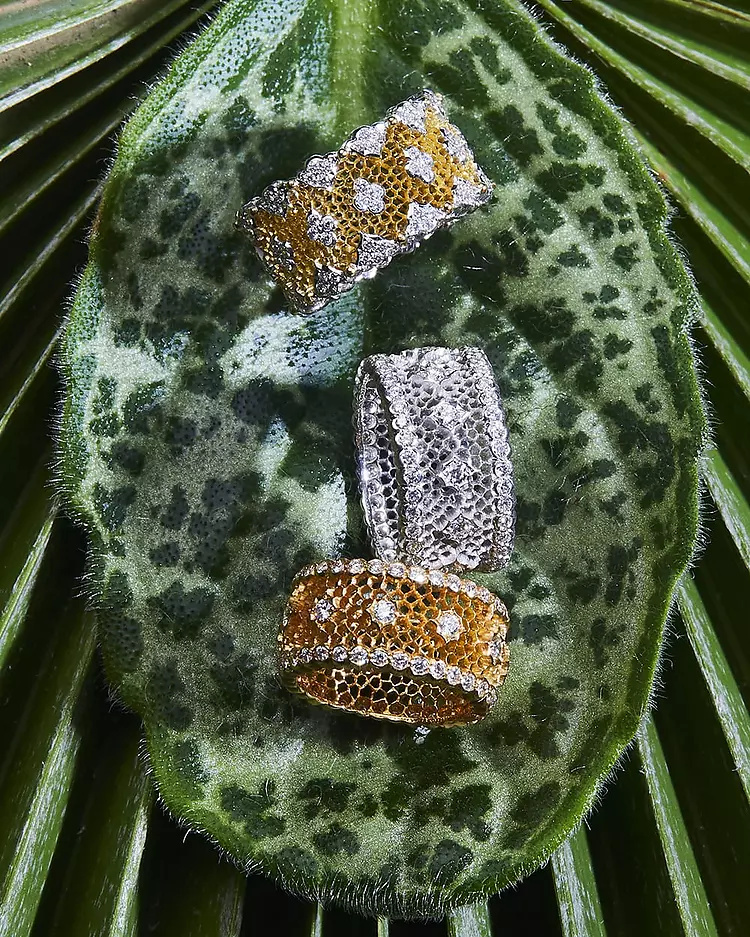
This type of ring has been interpreted in various decorative patterns. Mario Buccellati’s design is known for its continuous white gold vine branches theme, with leaves adorned with 16 rose-cut diamonds (0.86 carats), interspersed with small golden mulberries (0.86 carats).
Gianmaria introduced the Rombi theme, reminiscent of geometric shapes on Persian carpets. The light-colored white gold openwork of the rhomboid elements is further adorned with 42 brilliant-cut diamonds (0.99 carats), while the golden yellow borders are carved in the “modellato” style.
Drawing inspiration from precious fabrics, Andrea combines delicate honeycomb gold openwork with small shapes of damask edges, both in white gold, with 144 brilliant-cut diamonds blooming on top (0.81 carats).
This type of ring has been very popular among fashion queens and Hollywood celebrities, including Jacqueline Kennedy and Frank Sinatra.

Cocktail rings are a recurring theme in the Buccellati style. Large in size, rich in color, precious, and varied in shape, they gained popularity in the 1930s thanks to Mario Buccellati, but became iconic in the 1950s and 60s with Gianmaria.
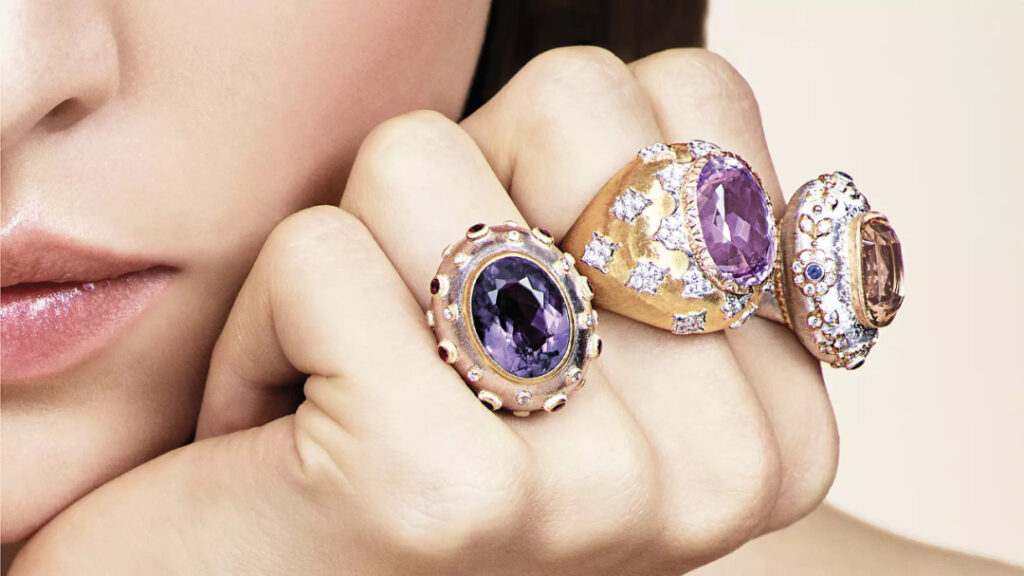
Another of his intuitions was the study of rings, known as “botoletta” due to their circular domed head shape, “musone” due to their scaly head and handle, and “pagoda.” The latter is Gianmaria’s tribute to the East, its architecture, and the success of his regular exhibitions in Hong Kong and Japan.
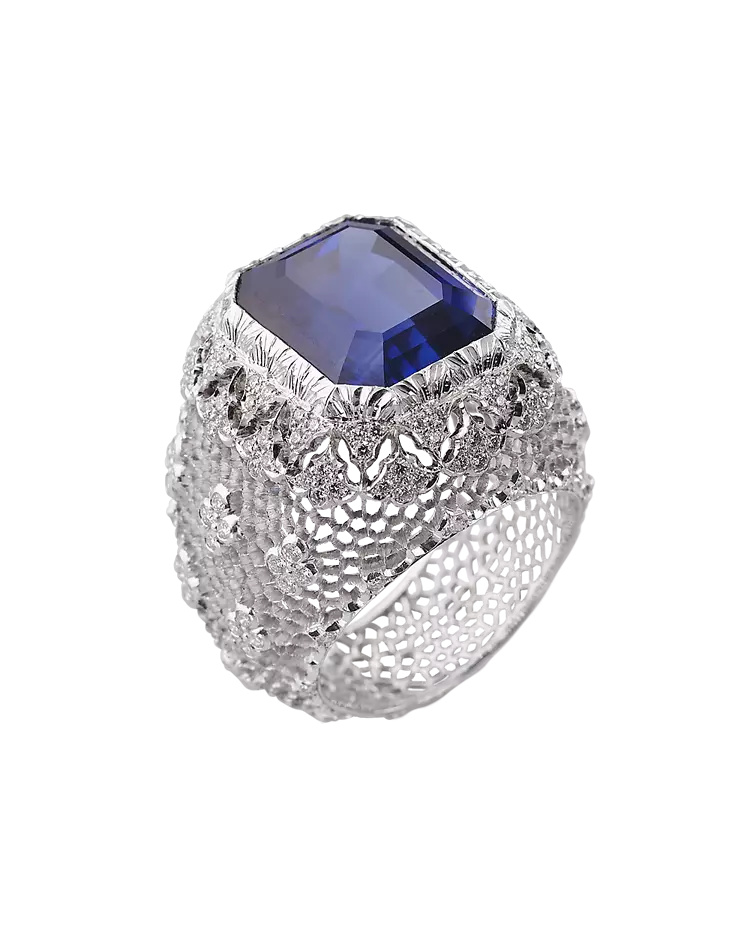
The brand’s jewelry, such as the precious pagoda ring from 1975, perfectly embodies the colorful and joyful spirit of that era. The enormous royal topaz (25 carats) stands out for its intense color, appearing almost trapped in a precious lace-like golden cage adorned with 84 brilliant-cut diamonds (4.1 carats).
The stem supporting the weight of the precious stone features the typical alternating yellow and white gold engraved with leaf patterns. Gianmaria’s son Andrea prefers the ethereal geometry of tulle. In his 2015 musone ring, he imprinted his distinctive mark on the delicate white gold handle: multi-leaf shapes.
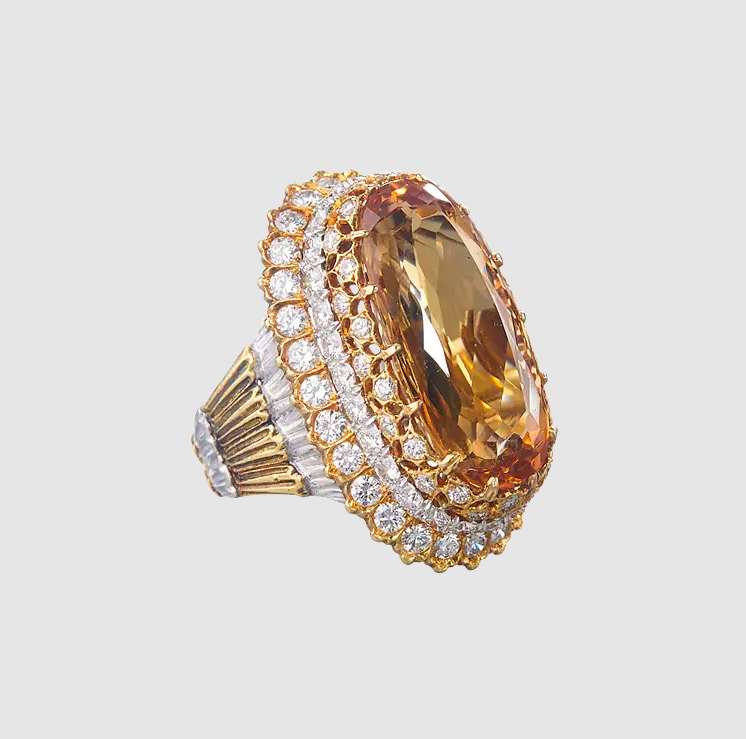
The creation of cocktail earrings also begins with the selection of gemstones, followed by careful study and installation to enhance the wearer’s beauty and uniqueness. From Mario Buccellati’s openwork pendants purchased by Spanish soprano Conchita Supervía in 1929 to Federico Buccellati’s 1973 design featuring golden leaves and baroque pearls, the versatility of the Buccellati signature stands out.
Amethysts, white pearls, intricately carved tourmalines, beryls, rubies, and sapphires are all combined in different cuts, shapes, and colors. Gianmaria Buccellati designed a complete series to celebrate the brand’s anniversary in the American market, demonstrating that creativity is limitless.

These earrings, designed by Gianmaria in 2008, are set with 254 brilliant-cut diamonds (10.47 carats) and adorned with two pearls (91.34 carats).

For over a century, nature has been an inexhaustible source of inspiration for the Buccellati family. The constant exploration of herbs, flowers, and animals has sparked their curiosity and imagination. This ranges from Mario’s silver openwork bracelets with leaf engravings set with rubies and sapphires designed for Gabriele d’Annunzio in the 1920s, to Andrea’s 2020 necklace inspired by Monet’s Impressionist paintings and his Giverny garden.
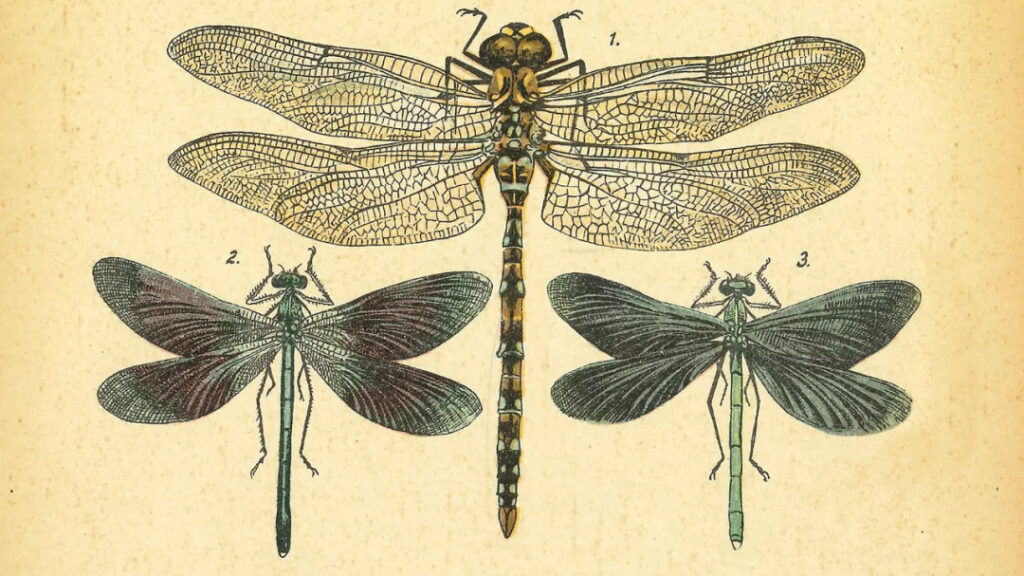
Since the 1980s, the begonia flower has been a source of inspiration for Gianmaria’s creations. The delicate ruffled petals feature “rigato” and “segrinato” engraving patterns, made with gold sheets of different colors, bringing life and movement through embossing techniques. The flower’s stigma is adorned with 21 brilliant-cut diamonds (0.6 carats).
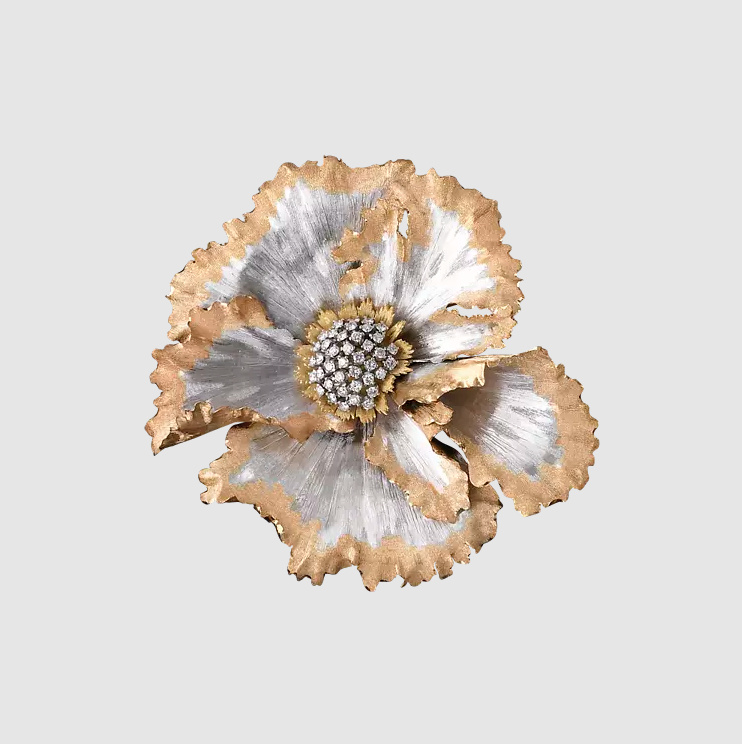
The image below shows Lucrezia Buccellati wearing a white and yellow floral set designed by Andrea Buccellati in 2020, set with Paraiba tourmalines, tsavorites, and diamonds.
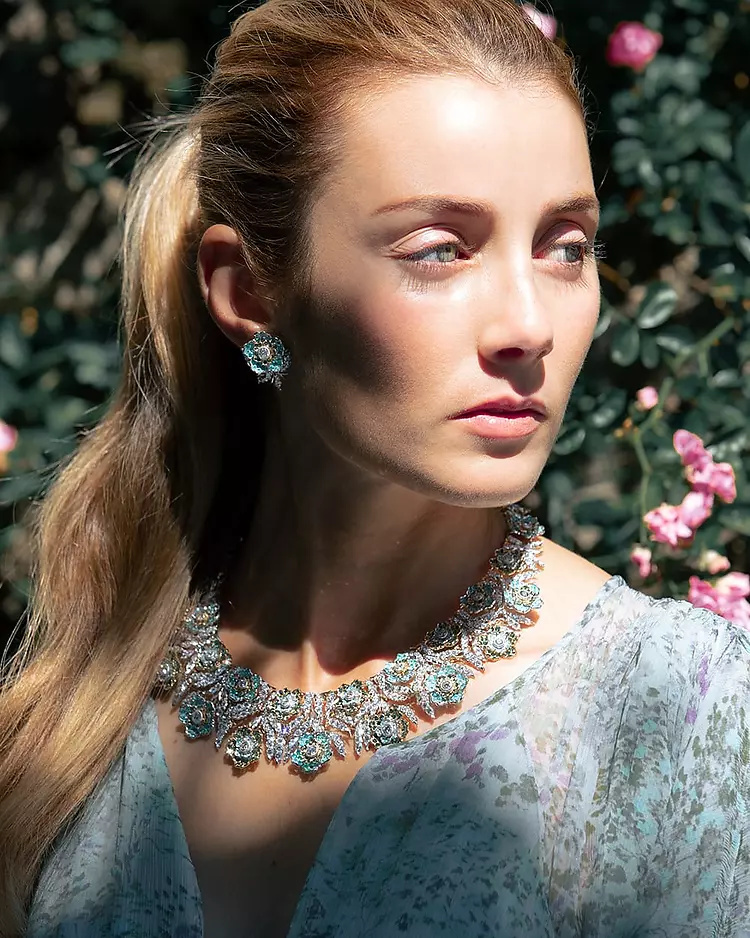
Gianmaria dedicated one of the brand’s iconic collections to his daughter Maria Cristina and her refined elegance. In the Macri collection, named after her, the artistry of “rigato” engraving reaches its pinnacle.
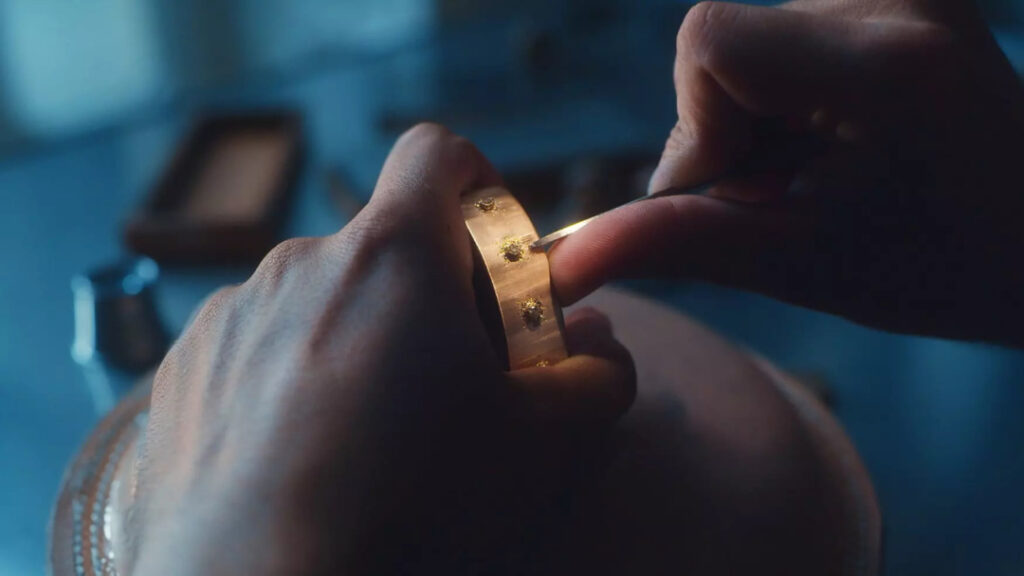
The collection’s bracelets, rings, and earrings feature an elegant “chiaroscuro” effect, with stunning star-shaped diamond roses rising like architectural details from a very finely textured surface, using the typical Buccellati style of two-tone gold.
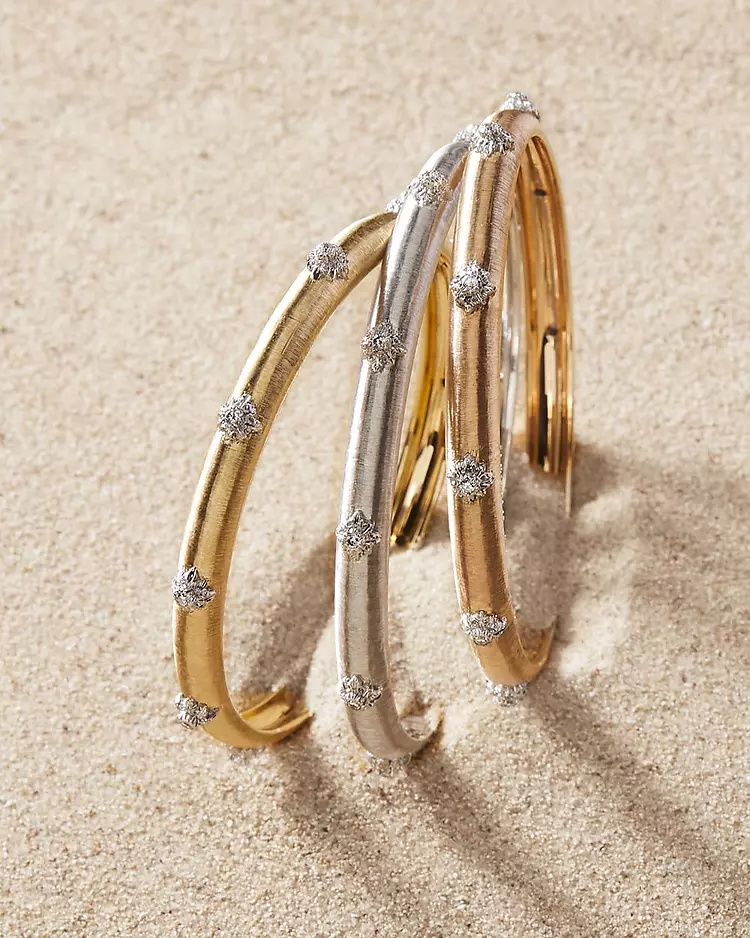
Following this, Andrea Buccellati turned to the Macri Giglio collection, adopting the smooth texture of “rigato” and playing with its matte quality by adding small, diamond-illuminated lilies. In Macri Color, the chromatic beauty of aquamarines, amethysts, and rubies is combined with finely engraved surfaces.
From the 1980s to the present day, Macri has remained one of the brand’s most popular collections, becoming a symbol of discreet elegance and pure Milanese style.

The Hawaii collection originated in the 1930s, inspired by founder Mario Buccellati’s brilliant vision. Influenced by the speed and movement in Futurist paintings, he conceived the idea of making small circles from hand-twisted gold wire, intertwining them to form a long chain. This design caused a sensation at the time due to its extreme modernity and is still highly appreciated and recognized today.
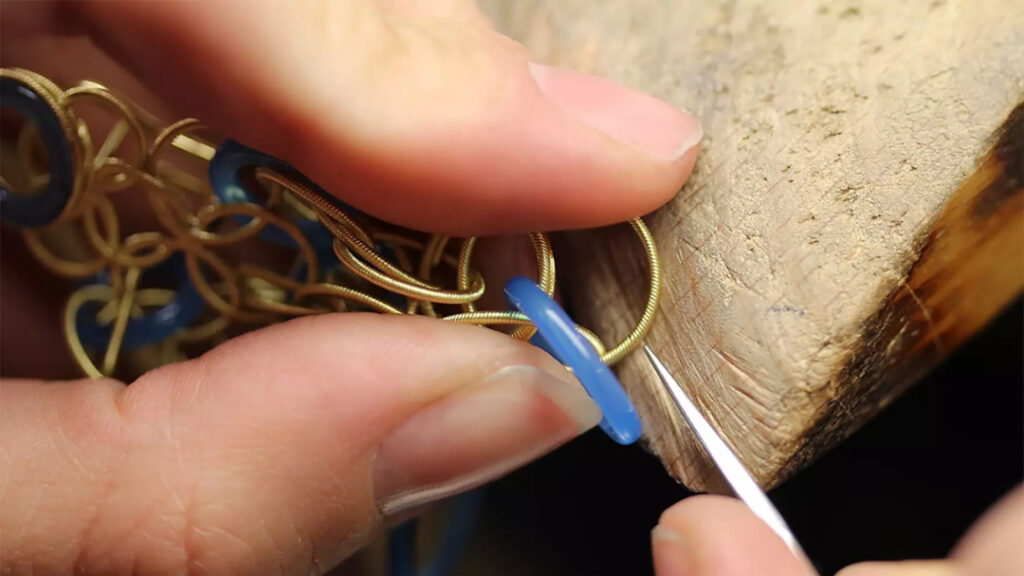
In the 1990s, Andrea Buccellati enriched this collection by experimenting with different lengths, introducing cascading pendant earrings, shorter necklaces, and bracelets in gold and various colors. The recent Hawaii Color collection incorporates colored gemstones including opals, jade, agates, and chalcedony cut into small circles, lending additional color variations to the design.
Hawaii Diamonds: a refined reinterpretation of the iconic design, adding precious white gold circles set with brilliant-cut diamonds.
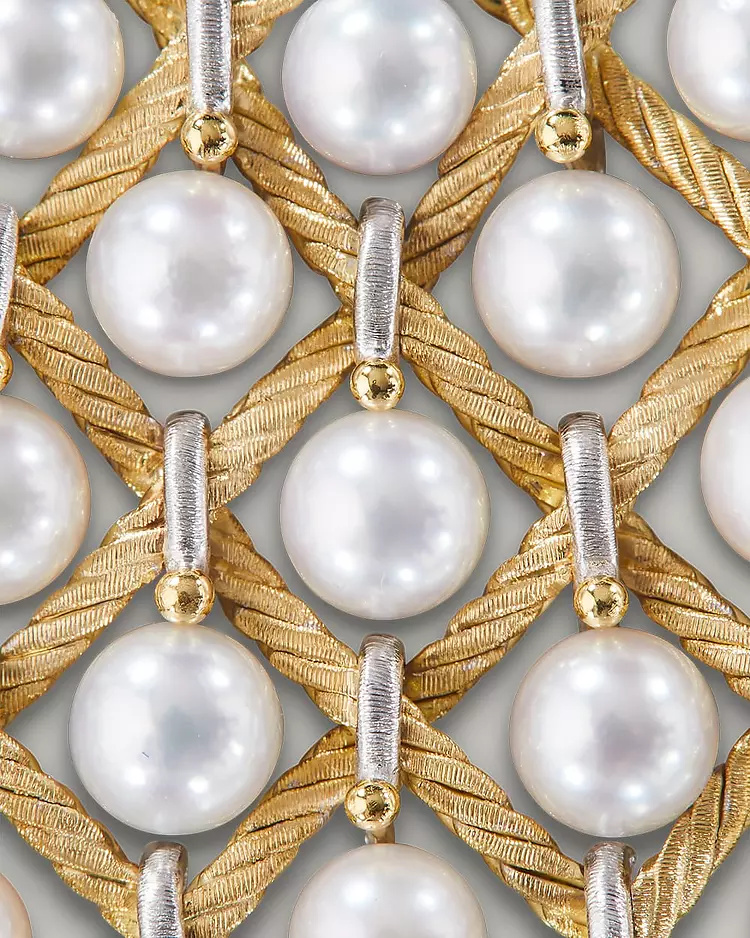
The Étoilée collection is similarly a product of Andrea Buccellati’s creative talent. Four golden chains intertwine to form oval geometric shapes, within which are diamond-set white gold lilies. It’s an ode to movement and Buccellati’s mastery, transforming chains into a precious element.

Inspired by the Italian Renaissance, the Opera collection celebrates the beauty of pure symmetry, represented by flowers, a recurring symbol and theme in the brand’s creations.
The new Buccellati logo, introduced by Andrea in 2014, echoes the stylistic features of the Doge’s Palace facade in Venice. It is integrated into the jewelry as a four-leaf openwork element, delicately adorned with diamonds. The iconic tulle work adds extra lightness and transparency to the collection.
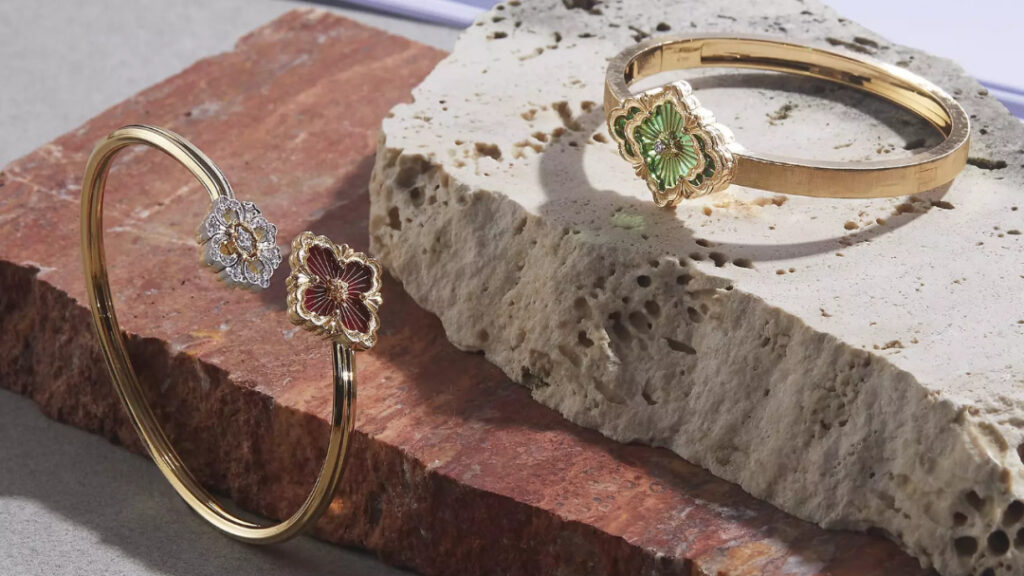
The floral theme is fully expressed in the Buccellati Cut diamond collection, which debuted in 2019 to celebrate the brand’s anniversary. Andrea’s wish was to crystallize this century of history into a new diamond cut embodying harmony and geometry. The Buccellati Cut diamond, with 57 facets, is the result of years of research and study, recognized and certified by the GIA.

This column represents the brand’s present, paying homage to the origins and future of the Buccellati style, where past traditions are considered a heritage, reinterpreted through contemporary forms to create timeless beauty.

Finally, let’s appreciate some classic pieces from this show!









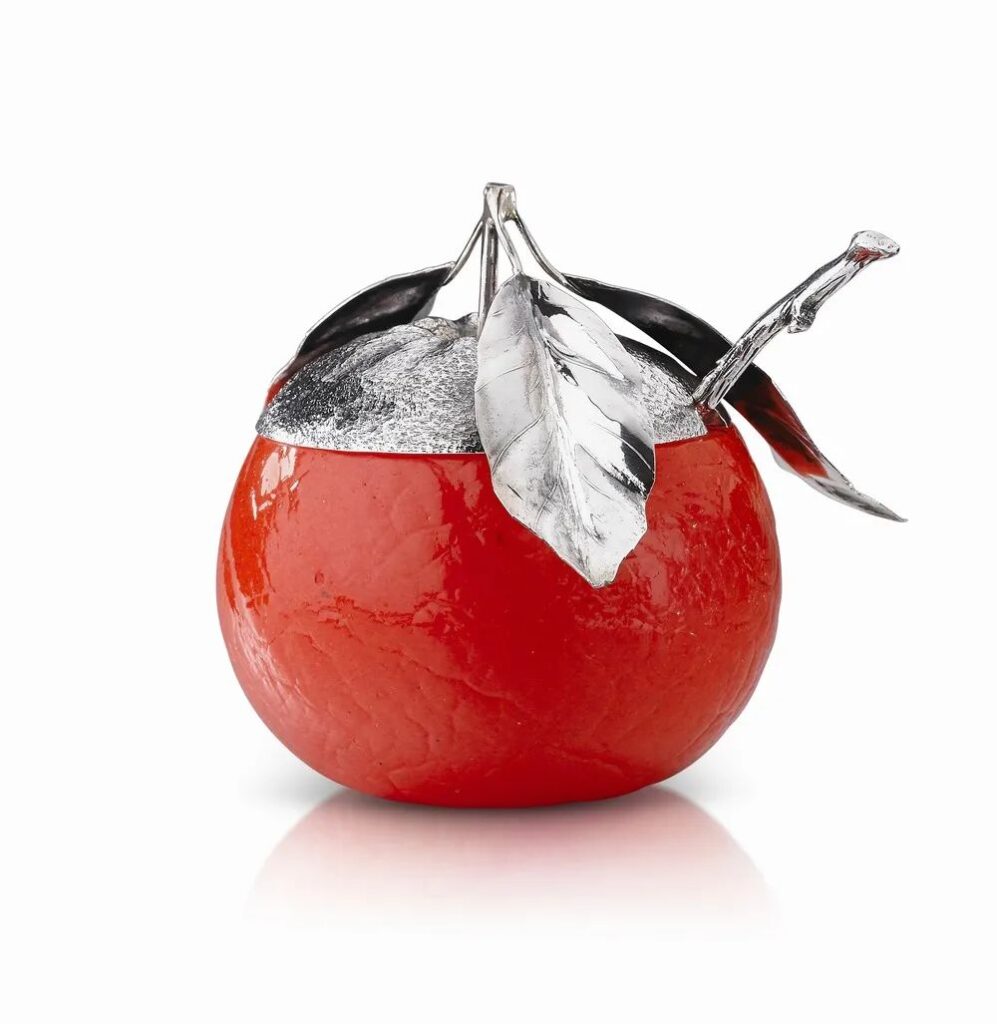


Buccellati: The Ultimate Showstopper in Jewelry Craftsmanship
Tweet
Further Reading
